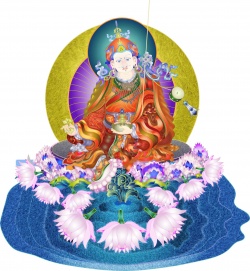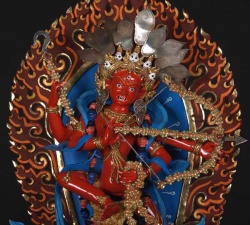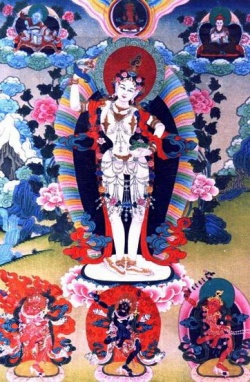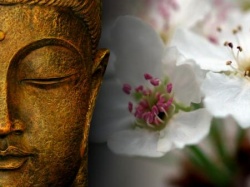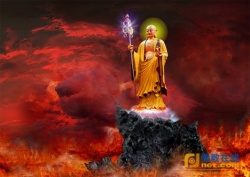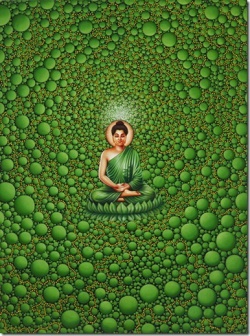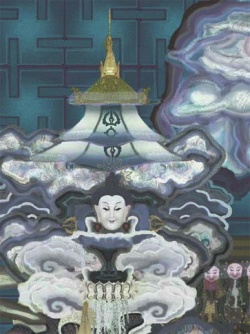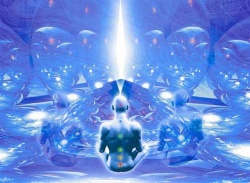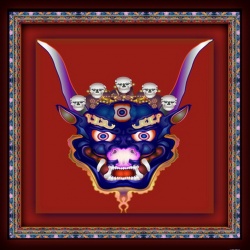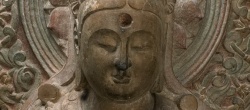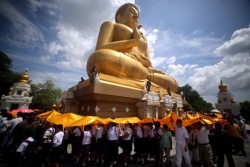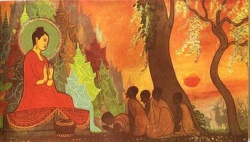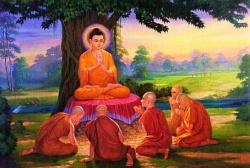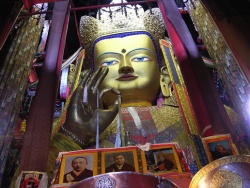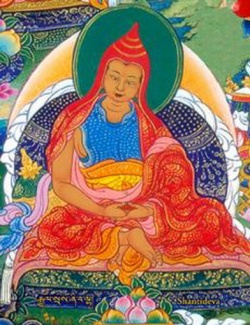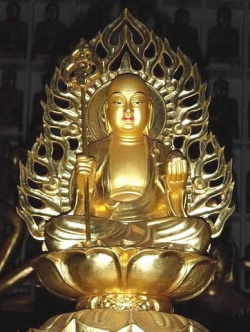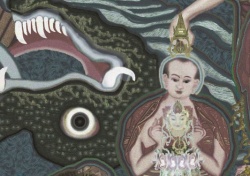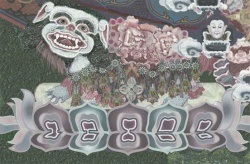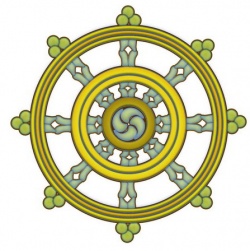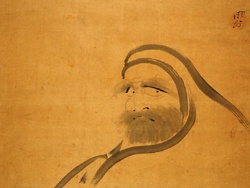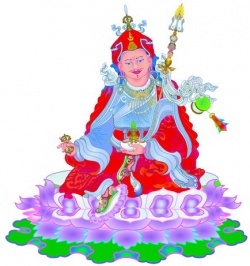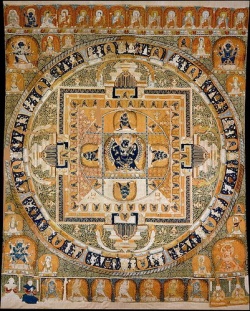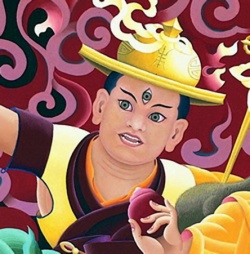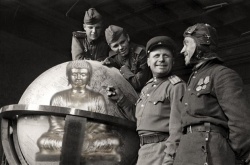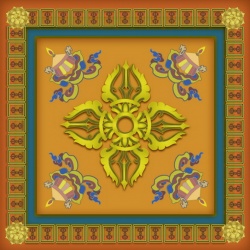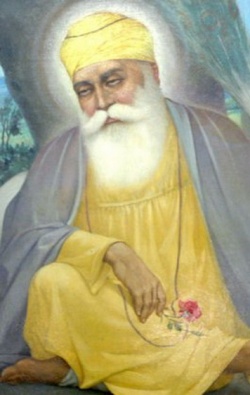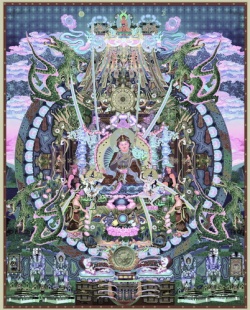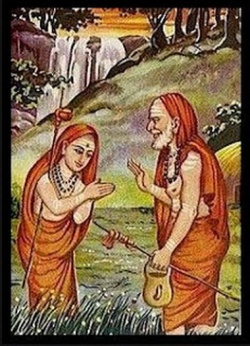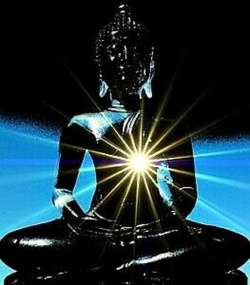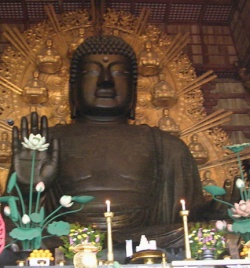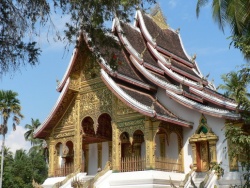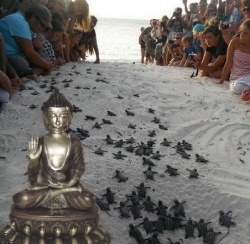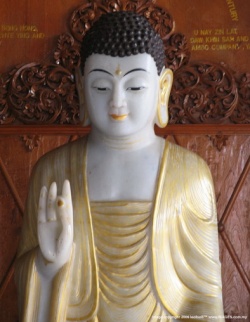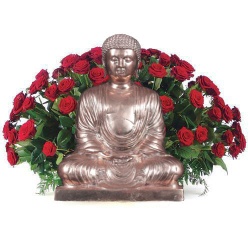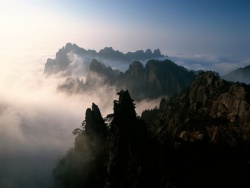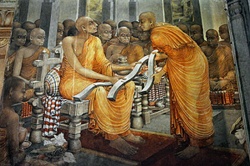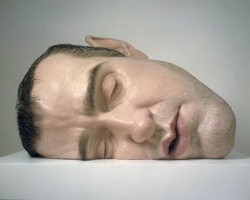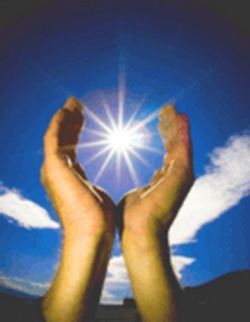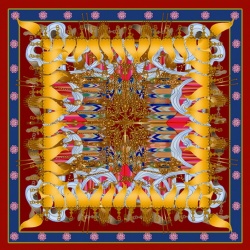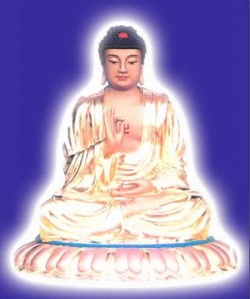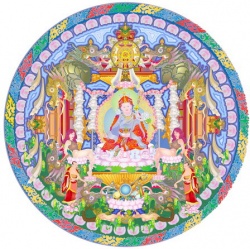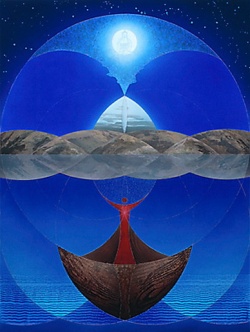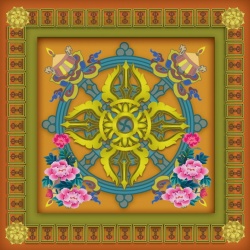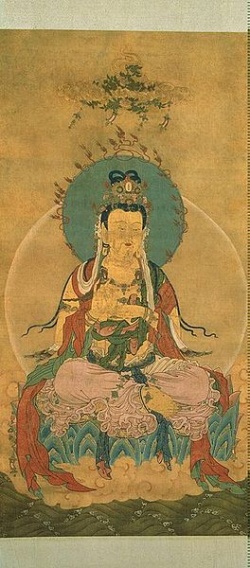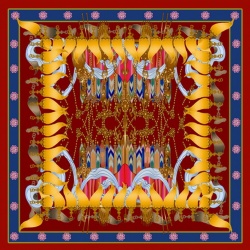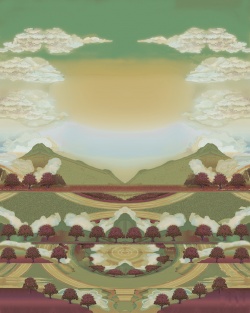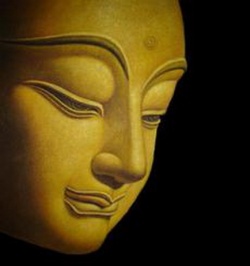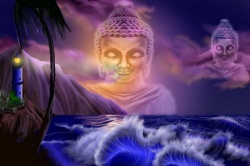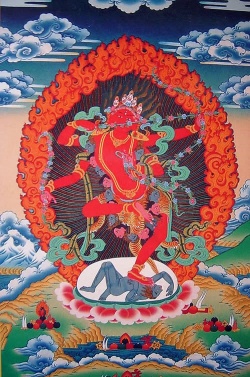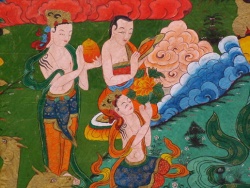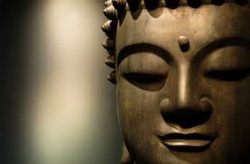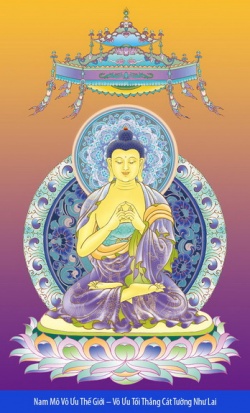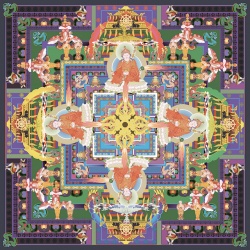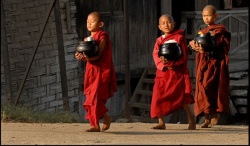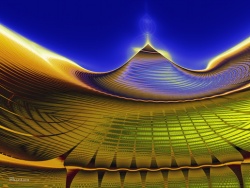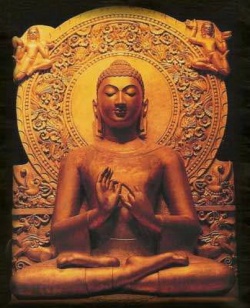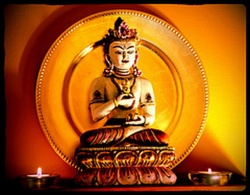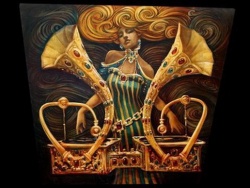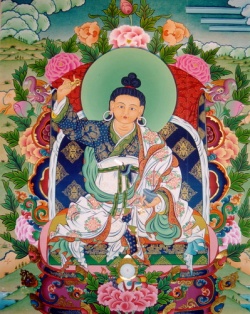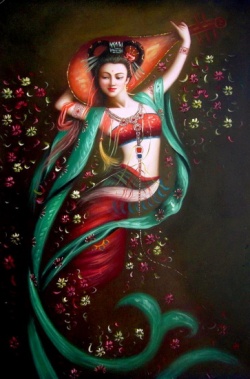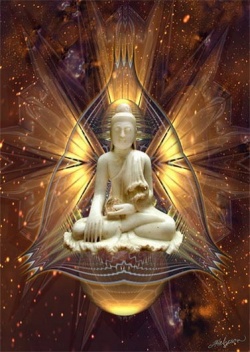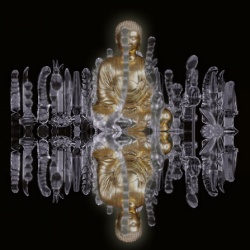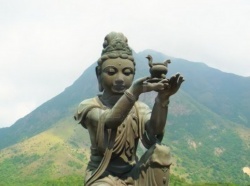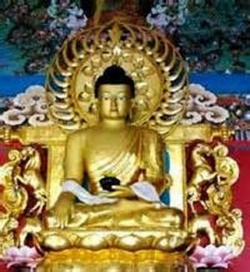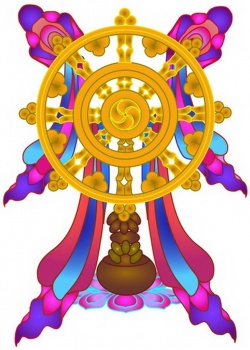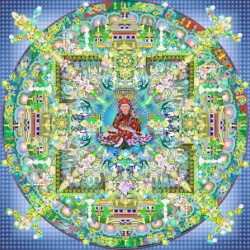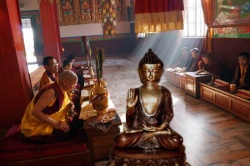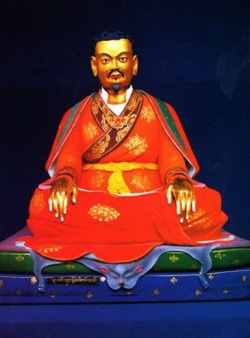The Dharma Flower Sutra seen through the Oral Transmission of Nichiren Daishōnin: The Seventh Chapter on The Parable of the Imaginary City
The Dharma Flower Sutra
seen through the Oral Transmission of
Nichiren Daishōnin
The first important point, with regard to the [[imaginar(psychological) city.
The Oral Transmission on the Meaning of the Dharma Flower Sutra (Ongi Kuden) says that here the word “imaginary” is a dharma that affects our physical perceptions, whereas, in this case, the word “city” is a dharma that we can sense in our minds. These two dharmas that refer to both our physical and psychological experiences were seen as something impermanent, which was the intention of the Buddha doctrines that were expounded in accordance with the capacity of the hearers, but which does not represent the ultimate teaching of the Dharma Flower Sutra (Hokke-kyō). The intended meaning of the Dharma Flower Sutra (Hokke-kyō) is that this particular impermanency is expounded as something that endures forever. In this instance, the imaginary city is equated with the place where the treasure is.
Coming to the point, Nichiren and those that follow him are those people, who reverently recite Nam Myōhō Renge Kyō and become aware of the fact that both our physicality and our minds are the Utterness of the Dharma (Myōhō, Saddharma) and that the imaginary city is not something separate (soku) from the place where the treasure is.
The imaginary city refers to the nine realms of dharmas of ordinary people and the place where the treasure is implies the Dharma realm of the Buddha. It is a journey of five hundred yojanas from the imaginary city to the place where the treasure is. These five hundred yojanas represent our unenlightenment and the delusion of our misleading views, doubts, and fears that hold us all back, in mystifications and unclearness.
When we appreciate and understand that these five hundred yojanas, that are the makeup of the different kinds of troublesome worries (bonnō, klesha) that plague us, are none other than the five ideograms for Myōhō Renge Kyō – which is the Utterness of the Dharma (Myōhō) [entirety of existence) permeated by the underlying white lotus flower-like mechanism of the interdependence of cause, concomitancy and effect (Renge) in its whereabouts of the ten (psychological) realms of dharmas (Kyō) – the imaginary city becomes the place where the treasure is. The verb “to become”, in the expression, of “the imaginary city becomes the place where the treasure is”, is the Buddha wisdom of Nam Myōhō Renge Kyō. Therefore, every instant of mind in the imaginary city is the ultimate truth (soku) of being in the place where the treasure is.
The two dharmas of physicality and also what goes on in our heads are said to be impermanent, according to the teachings of Shākyamuni they were an expedient means, but not necessarily the ultimate teaching of the Buddha. However, the exposition of infinite perpetuity is the essential doctrine of the Dharma Flower Sutra (Hokke-kyō). To obliterate our feelings for our attachment to impermanency [such as being worried about living or dying] means that we cancel all our notions that we attach to the imaginary city [which refers to our troublesome worries (bonnō, klesha) of various kinds and the cycles of living and dying, since the Utterness of the Dharma (Myōhō, Saddharma) is the here and now of each instant we live].
The imaginary city could be likened to our skin and flesh and our skeletal framework that alludes to the place where the treasure is [just as the quintessence of life underlies the whole of existence). When we come to inwardly feel and realise that both of these two dharmas and also what goes on in our heads are the Utterness of the Dharma (Myōhō, Saddharma), these are the extremities of our lives, so that the imaginary city being inseparable from the place where the treasure is becomes the individuating substantiation of who we really are. This individuating substantiation involves both impermanency and eternity, in which the interdependence of cause, concomitancy and effect becomes the all-inclusive, unobstructed accommodation of phenomena or physicality (ke), and the relativity of noumena (kū, shūnyatā), along with these two elements, combined together, form the middle way of reality (chūdō jissō).
This of course is not something apart from the two ingredients of all existence, which are 1) that life continually changes according to karmic circumstances, and 2) the fundamental principle of existence as it is expounded in the Second Chapter on Expedient Means. Each instant of mental activity and perception is the silent brilliance [that is the enlightenment which is sometimes seen in near-death states] and the reality of the Dharma that underlies our daily lives. Each instant of mental activity is Nam Myōhō Renge Kyō, which means to devote our lives to and found them on (Nam[u]) the Utterness of the Dharma (Myōhō) [entirety of existence) permeated by the underlying white lotus flower-like mechanism of the interdependence of cause, concomitancy and effect (Renge) in its whereabouts of the ten (psychological) realms of dharmas (Kyō). This has to be an instant of life in which one shows a faith without doubt. So one should deeply ponder over the concept of “not being separate from (soku)” or the single word “instant”, which in itself is all-embracing.
The Buddha said to the monks: In the distant past of an uncountable and boundlessly inexpressible, imponderable number of kalpas ago. there was a Buddha called the Tathāgata Universally Pervading Superlative Wisdom (Daitsū Chishō, Mahābhijñā Jñānābhibhū) . . .
The second important point, with regard to the Buddha Daitsū Chishō (Mahābhijñā Jñānābhibhū), whose name, when translated, means Buddha of the Universally Pervading Superlative Wisdom.
The Oral Transmission on the Meaning of the Dharma Flower Sutra (Ongi Kuden) states that “Universally Pervading” refers to the sovereign of the mind, which is the fundamental enlightenment at the very foundation of our existences and, when represented visually, is of exactly the same makeup as the Fundamental Object of Veneration (gohonzon).
[This sovereign of the mind is the same as the ninth cognition (daikushiki, amarashiki, amala-vijñāna) that renders the fact of our being aware, as to whether we are consciously awake, dreaming, or in the dimension of the dead. This ninth cognition (daikushiki, amarashiki, amala-vijñāna) is also referred to as the amarashiki (amala-vijñāna). Our eighth cognition is held to be a producer of dharmas that are impermanent, while amarashiki (daikushiki, amala-vijñāna) is designated as being undefiled, the immanence of all existence, and is independent of all action.]
The “superlative wisdom” refers to the multiplicity of fantasies, thoughts, ideas, and troublesome worries (bonnō, klesha) that disquiet our minds. The “Universally Pervading” part of this Buddha’s name is stated to be the sovereign of our minds, which is the foundation of our psyches. This is the principle of the eternal and unchanging basis of our respective realities (fuhen shinnyo no ri) that was expounded as the real aspect of all dharmas in the part of the Dharma Flower Sutra (Hokke-kyō) in which the teachings that are derived from the external events of Shākyamuni’s life and work (shakumon), whereas the “Superlative Wisdom” part of this Buddha’s name refers to the reality of our lives which is the wisdom to perceive that they are continually changing according to karmic circumstances (zuien shinnyo no chi). This is a concept that belongs to the teachings that refer to the original archetypal state (honmon). The full name of this Buddha entails the whole of our bodies and persons.
Now Nichiren and his followers reverently recite Nam Myōhō Renge Kyō which means to devote our lives to and found them on (Nam[u]) the Utterness of the Dharma (Myōhō) [entirety of existence) permeated by the underlying white lotus flower-like mechanism of the interdependence of cause, concomitancy and effect (Renge) in its whereabouts of the ten (psychological)psychological)]] realms of dharmas (Kyō). Such a behaviour is universally pervading. Reciting this title and theme (daimoku) encompasses all the possibilities of existence and is therefore the superlative wisdom.
The wisdom of the persons who devote themselves to and hold faith in the Dharma Flower Sutra (Hokke-kyō) and, in particular, the person of Nichiren, is a hundred thousand myriads of times superior to the huge understanding of the schools of the provisional teachings. [i.e., the teachings of Shākyamuni) You should know that this is the superlative wisdom.
The concept of the adverb “universally” represents all the dharmas of materiality, and the word “pervading” designates all the imaginable dimensions that exist in our minds. As a result, “universally pervading” is said to include our cycles of living and dying that are the normal activity of our minds, bodies, and persons. All this can be referred to as the superlative wisdom. When we really think about it, then those whose practise is to recite Nam Myōhō Renge Kyō are the Buddha Universally Pervading Superlative Wisdom (Daitsū Chishō, Mahābhijñā Jñānābhibhū) and the embodiment of his universally pervading superlative wisdom, while, at the same time, the sixteen sons of this Buddha are all that goes on in our minds.
. . . . Worthy of offerings and is correctly and universally enlightened, whose knowledge and conduct was perfect, completely free from the cycles of living and dying, yet with a full understanding of the realms of existence, lord supreme, the master who brings the passions and delusions of sentient beings into harmonious control, the teacher of humankind and the deva (ten), the Buddha who is the World Honoured One. The realm, whereupon he depended for an existence, was called Well-attained, and the kalpa, in which he was active, was called Universal Token.
Venerable monks, can you imagine the number of grains of earth in all the three thousand, great thousands of finite worlds in existence and that someone wanted to grind them down into a fine powder in order to make ink?
Then this person goes in an easterly direction, covering a thousand terrains, which are the abodes of sentient beings, and writes down a tiny point, as small as a speck of dust. Then he crosses over another thousand terrains and makes another tiny point. This person continues in this fashion, until all the ink pigments made out of soil are exhausted.
- What do you think about this? Would a mathematician or the disciple of a mathematician be able to assign a limit to all these terrains or even know their number?
- No, World Honoured One.
- Well, Venerable monks, imagine if one were to reduce all these finite worlds that were passed over by the person who either did or did not make an ink mark, and that each grain of dust represents a kalpa. Then after this Buddha has passed over to the extinction of nirvana, it is even a greater number of boundless, uncountable hundreds of thousands of myriads of kalpas ago.
- By my strength of the vision and perception of the Tathāgata, I look upon this far distant past, as though it were still this present-day.
Thereupon the World Honoured One, wishing to reiterate the significance of what he had said, expressed it in the form of a metric hymn.
I remember,
in a bygone dimension of existence,
that was uncountable
boundless kalpas ago,
there was a Buddha
who was the most venerated person
who walked on two legs.
His name was Universally Pervading
Superlative Wisdom (Daitsū Chishō, Mahābhijñā Jñānābhibhū).
Can you imagine
that there was a person
who had the strength
to grind into powder
three thousand great thousands
of the objective terrains
of sentient beings,
so that all the tiny particles
were pulverised
into the pigments for ink?
Then, after this person
had crossed over
a thousand terrains
upon which sentient beings
depend for their existence,
this person then puts down a dot,
as tiny as a speck of dust.
This person continues
in this manner,
until all the pigments of the ink
are entirely exhausted,
without taking into consideration
as to whether these terrains,
upon which beings
depend for their existence,
were marked with a tiny dot.
Then, if the total
of all these universes
were pulverised into a fine dust
and one were to imagine
that each tiny particle was a kalpa [a kalpa being a whole universe from its beginning to its termination],
this Buddha had already passed over
into the extinction of nirvana
even more than this numberless amount
of kalpas ago.
On account of the unobstructed insight
of the Tathāgata,
he is able to see the extinction
of this Buddha into nirvana
and know the number
of intellectual seekers (shōmon, shrāvaka)
and bodhisattvas,
as though this extinction into nirvana
is right now before his eyes.
All you monks should realise
that the wisdom of the Buddha
is immaculate, subtle,
all-embracing, and free from any taint
of illusion
that extends as far as
the uncountability of the kalpas.
After this metric hymn, the Buddha said to the monks: The lifespan of the Buddha Universally Pervading Superlative Wisdom (Daitsū Chishō, Mahābhijñā Jñānābhibhū) was five hundred and forty myriads of myriads of kalpas long. In the beginning, this Buddha sat at the site of enlightenment under the bodhi tree. After having defeated the armies of the demon-like deva (ten) that dwells in the highest of the six heavens of desire above Mount Sumeru, who is the powerful influence that can preclude the realisation of our inherent enlightenment [the Demon of the sixth heaven, (Dai Roku Ten no Ma' ō)], this Buddha attained the unexcelled, correct, and all-embracing enlightenment. However, the thirty-two special attributes of all the Buddhas did not appear on his person. Instead, he remained seated in a cross-legged position without moving his body, for as long as ten minor kalpas.
But even then these special attributes did not become apparent. Then, at that time, all the deities of the heaven of the thirty-three deva (tōriten trāyastrimsha), which is on the platform on top of Mount Sumeru [where in the centre is the palace of Taishaku (Indra), on each of the four corners of this platform there are the palaces of eight other deva (ten), making this mountaintop the abode of thirty-three deva (ten)] – all these deva (ten) decided to establish under the bodhi tree a lion throne that was as high as a yojana. It was to be on this throne that this Buddha should fully attain all the special attributes of having substantiated the unexcelled, correct, and all-embracing enlightenment.
As soon as he sat on the throne, all the Brahmanic deva (Bonten) caused it to rain heavenly flowers over an area of a hundred square yojanas. A perfumed wind breezed in from time to time, in order to blow away the faded blossoms, while more fresh flowers floated down. It kept on raining flowers without interruption for a full ten minor kalpas, as an offering to the Buddha until his extinction into nirvana.
Those four deva sovereigns (ten’ ō, deva-rāja) continued to beat on their heavenly drums, while all the other deva (ten) played sage-like music, for a full period of ten minor kalpas. [The four deva sovereigns (ten’ ō, deva-rāja) are guardians of the world who are Taishaku’s (Indra) generals who dwell on each side of Mount Sumeru in order to ward off malicious demons and spirits from the dimensions of existence. These four sovereigns are inscribed on the four corners of the Fundamental Object of Veneration (gohonzon) of various Nichiren schools.] All the special attributes of the Buddhas appeared on the Tathāgata Universally Pervading Superlative Wisdom (Daitsū Chishō, Mahābhijñā Jñānābhibhū), showing that he had attained the unexcelled, correct, and all-embracing enlightenment.
Before the Buddha had left home in order to enter the path of religious austerities, he had sixteen sons. The name of the first-born was Chishaku (Jñānākara), which when translated, means Accumulated Wisdom. Each one of the Buddha’s children possessed all sorts of diverse and rare toys. When these children got to hear about their father’s attainment to the unexcelled, correct, and all-embracing enlightenment, they all threw aside their rare and precious toys and made their way to the place where this Buddha was. Also, all their mothers, weeping and crying, followed them along the road.
The third important point that deals with the phrase from the sutra, “Also, their mothers, weeping and crying, followed them along the road.”
The Oral Transmission on the Meaning of the Dharma Flower Sutra (Ongi Kuden) states that the words “all of their mothers” refer to the mothers of the sixteen sons of the Universally Pervading Superlative Wisdom (Daitsū Chishō, Mahābhijñā Jñānābhibhū). The real implication of the word “mother” presupposes our inborn, intrinsic uncertainty and difficulty of understanding what life is all about. The word “mother” can, in this sense, be conceived of as that element which maternally engenders what we mistakenly perceive life to be. As we transmigrate from one life to one death, and then more lives and deaths, we are continually accompanied by this mother-like begetter of our inherent unaccountability of what life really is. But, when we return to the extinction of nirvana, which is the quintessence of existence and our exit from the delusive cycles of living and dying, we get rid of this mother-like begetter of our inherent bewilderment.
This mother-like begetter of our inborn bewilderment is embodied in persons who take refuge in and recite the name of the Buddha Amida (Amitābha), which is a partial teaching for the afterlife that is very close to the concept of “pie in the sky”. The inborn bewilderment is also included among the adherents of the Zen School, which is another provisional and only partial teaching that would stipulate that existence only consists of illusionary noumena (tankū), without taking into account the apparent fact of materiality (ke) and the middle way of reality (chūdō jissō), both of which according to the Dharma Flower Sutra (Hokke-kyō) “are neither a reality nor a nothingness” (hijitsu hiko). Then there are those “followed” by this inborn bewilderment who are followers of the Tantric and Mantra Schools (Shingon), which are similar to the practises of the Tibetan Schools that may or may not be a literal interpretation of the Indian variant of the provisional teachings that are riddled with superstition and esoteric otherworldliness. All the followers of these partial teachings are “followed by their mothers along the road” and are people who distort the teaching of enlightenment.
Nevertheless, in the end, after the Dharma Flower Sutra (Hokke-kyō) has been widely propagated, then all the adherents to these other incomplete doctrines will become votaries of this teaching. Instead, they will all wish to come face to face with the Fundamental Object of Veneration (gohonzon). Here in this sutric text, this is implied in the name of the Tathāgata Universally Pervading Superlative Wisdom (Daitsū Chishō, Mahābhijñā Jñānābhibhū).
The grandfather of the sixteen children was a sage-like sovereign whose chariot wheels rolled everywhere without hindrance (tenrinnō, chakravartin). Accompanied by a hundred of his great ministers, along with more than a hundred thousand myriads of myriads of ordinary people who were crowding around these royal and noble personages, they made their way to the site of enlightenment. All of these persons wished to approach the Tathāgata Universally Pervading Superlative Wisdom (Daitsū Chishō, Mahābhijñā Jñānābhibhū).
The fourth important point, with regard to the sutric passage: “The grandfather of the sixteen children was a sage-like sovereign whose chariot wheels rolled everywhere without hindrance (tenrinnō, chakravartin). Accompanied by a hundred of his great ministers, along with more than a hundred thousand myriads of myriads of ordinary people who were crowding around these royal and noble personages, they made their way to the site of enlightenment. All of these persons wished to approach the Tathāgata Universally Pervading Superlative Wisdom (Daitsū Chishō, Mahābhijñā Jñānābhibhū).”
The Oral Transmission on the Meaning of the Dharma Flower Sutra (Ongi Kuden) says that we can learn from this passage and can come to know what the original terrain of the embodiment of enlightenment of the Buddha consists of. The term “grandfather” is an alternative word for the realms of dharmas which, in the Sutra on the White Lotus Flower-like Mechanism of the Utterness of the Dharma (Myōhō Renge Kyō), in the Second Chapter on Expedient Means, [refers to the first three of the ten qualities of dharmas which are 1) in any way they make themselves present to any of our six sense organs, i. eyes, ii. ears, iii. nose iv. tongue, v. body, and vi. mind (Nyoze sō), 2) their inner qualities (Nyōze shō), and 3) their substance or reality or what they actually really are (Nyoze tai)].
Apart from these first three qualities of dharmas, there is no such thing as a sage-like sovereign whose chariot wheels roll everywhere without hindrance (tenrinnō, chakravartin). “Rolling everywhere without hindrance” implies things or beings coming into existence (shō) that live or last as long as they are supposed to (jū); then they degenerate and break up (i) and cease to exist altogether (metsu). The “sage-like sovereign” refers to the dharmas of the mind. These first three qualities of dharmas are the fathers and mothers, as the progenitors of all Buddhas of the past, present, and future.
Now, when Nichiren and those that follow him reverently recite Nam Myōhō Renge Kyō which means to devote our lives to and found them on (Namu[u]) the Utterness of the Dharma (Myōhō) [entirety of existence) permeated by the underlying white lotus flower-like mechanism of the interdependence of cause, concomitancy and effect (Renge) in its whereabouts of the ten (psychological)(psychological)(psychological)(psychological)(psychological)(psychological)(psychological)(psychological)(psychological)(psychological)psychological)]] realms of dharmas , they are acting out the role of both the mother and father of all the Buddhas, along with the function of their grandfather, who, as representative of the realms of dharmas (Kyō), is the sage-like sovereign whose chariot wheels roll everywhere without hindrance (tenrinnō, chakravartin).
[With regard to the sage-like sovereign whose chariot wheels roll everywhere without hindrance (tenrinnō, chakravartin), there are four kinds, indicating their rank. 1) The sage-like sovereign whose chariot wheels are made of gold rules the four continents of Mount Sumeru; 2) the sovereign whose chariot wheels are silver rules over the eastern, western, and southern continents; 3) the sovereign whose chariot wheels are made of copper rules the eastern and southern continents; and 4) the sovereign whose chariot wheels are made of iron rules the southern continent.]
The golden wheels represent life and the radiance of coming into being, and the silver wheels are akin to the colour of the whiteness of the bones of the dead and represent death. The copper wheels stand for the rosiness of maturity which leads into old age, and the iron wheels represent the coldness of infirmity and sickness.
These four kinds of wheels have a correlation with the four kinds of perception and wisdom of the Buddha that are also the reason for his appearance in the dimensions where existence takes place. These are 1) to open up this store of perception and wisdom, 2) to show what it means to sentient beings, 3) to cause humankind to apprehend and be aware of it, 4) to lead humankind onto the path of the perception and wisdom of the Buddha.
To eternally go round and round in the cycles of living and dying, throughout all the pasts, presents, and futures to come, is to be a sage-like sovereign whose chariot wheels roll everywhere without hindrance (tenrinnō, chakravartin). When we, as sage-like sovereigns, appear in the dimensions of existence, the treasure-like benefits of the rotation of the wheels of our chariots are the speech, words, their sounds, and our voices out of which the highest rotating wheel-like treasure is Nam Myōhō Renge Kyō. This is said to be the universal wisdom of enlightenment that runs through the entirety of existence.
The fifth important point, with regard to the sixteen sons of the sovereign.
The Oral Transmission on the Meaning of the Dharma Flower Sutra (Ongi Kuden) says that the ten in this number sixteen refers to the ten (psychological) realms of dharmas, which consist of 1) all the different kinds of suffering that exist, 2) craving, wanting, and needing, 3) instinctive animal behaviour, 4) the overbearing qualities and the anger of persons who coerce or pressure others, 5) ordinary human equanimity, 6) the impermanence of all delight and rapture, 7) intellectual seekers, 8) partial enlightenment as to what life is all about, 9) altruists who strive for the happiness of others, 10) the enlightenment of the Buddha. [The six in this number of sixteen sons pertains to the six sense organs which are eyes, ears, nose, tongue, body, and mind that can grasp six corresponding faculties, which are seeing, hearing, smelling, tasting, feeling, and being aware of what is going on.]
Here the word “sovereign” designates the ninth and completely undefiled cognition (amarashiki, amala-vijñāna), which is the awareness of being that follows us through all our living, lucid dreaming, and even in the dimension of death. Here the word “son” denotes all the multifarious and complex things that occur in our minds. All of this is the single principle of the real aspect of all dharmas, as it is implied in the number of sons of the Buddha Universally Pervading Superlative Wisdom (Daitsū Chishō, Mahābhijñā Jñānābhibhū).
Now Nichiren and those that follow him reverently recite Nam Myōhō Renge Kyō which means to devote our lives to and found them on (Nam[u]) the Utterness of the Dharma (Myōhō) [entirety of existence) permeated by the underlying white lotus flower-like mechanism of the interdependence of cause, concomitancy and effect (Renge) in its whereabouts of the ten (psychological) realms of dharmas (Kyō).
So, like the sixteen sons of the Buddha Universally Pervading Superlative Wisdom (Daitsū Chishō, Mahābhijñā Jñānābhibhū) who all attained the state of enlightenment in one or another of the various lands of the eight directions [of east, southeast, south, southwest, west, northwest, north, and northeast), we too will come to realise that all the eight kinds of suffering we undergo – 1) the suffering of being born and being alive, 2) the suffering of growing up and reaching old age, 3) the suffering of sickness and decline, 4) the suffering due to our uncertainties about what will happen to us when we die, 5) the suffering that comes about when we are separated from those we love, 6) the suffering that comes from being together with those whom we dislike or hate, 7) the suffering that comes from the fact that we cannot always have what we want, and 8) the suffering that derives from our attachment to the five aggregates that overshadow our original enlightenment [i. our bodily form, ii. reception, sensation, feeling and the functioning of the mind in connection with affairs and things, iii. conception, thought or discerning, the functioning of the mind in distinguishing, iv. the functioning of the mind in its processes with regard to likes, dislikes, good and bad, etc., v. the mental faculty that makes us think we are who we are on account of what we know], which are the apparent constituents of our bodies, minds, and the concepts of our environment – all these eight kinds of suffering are not separate from our inherent enlightenment (bonnō soku bodai).
All of them wished to approach the Tathāgata Universally Pervading Superlative Wisdom (Daitsū Chishō, Mahābhijñā Jñānābhibhū), so as to make offerings to him, render homage to him, to honour him and praise him. When all of these people had finally arrived, they bowed their heads to his feet, with the palms of their hands pressed together. They unanimously looked up to this World Honoured One and extolled him enthusiastically in the form of a metric hymn.
World Honoured One
whose prestige is to be able
to save all sentient beings,
who, after innumerable
myriads of ages,
finally attained
the state of Buddhahood,
thereby fulfilling all your vows,
what an excellent
and unsurpassed good fortune!
The appearance
of the World Honoured Ones
is exceedingly rare.
At the same time as he sat down,
his body, his hands, and his feet
became tranquil and at peace,
without moving
for as long as ten minor kalpas.
His mind was continually
in a state of fearless tranquillity
without ever becoming
distracted or troubled,
achieving the ultimate
eternal silence of extinction
and dwelling peacefully
in the Dharma,
without any taint of illusion
whatsoever.
Now that we see this World Honoured One
peacefully substantiating
the path of Buddhahood,
from which we gain
enormous benefits,
we are filled with joy,
and we proclaim our happiness.
Sentient beings
are constantly suffering
in distress and in the dark,
without a teacher to guide them.
Sentient beings do not even know
a path to end their suffering
and cannot even seek
deliverance from it.
Throughout the long night of existence,
they all fall into bad destinies,
further and further away
from the protection of the deva (ten).
They drift from darkness to darkness,
without ever hearing
a word for “the Buddha”.
Now, the Buddha has attained
the supreme Dharma of serenity,
without any illusoriness
whatsoever.
Both humankind and deva (ten)
have benefitted
from these enormous advantages.
This is why we bow our heads
and give back our lives and devote them
to the peerless World Honoured One.
When the sixteen princes finished praising the Buddha in terms of this metric hymn, they then urged him to set in motion the Wheel of the Dharma. This they all expressed in the following manner: World Honoured One, would you please expound the Dharma, in order that the numerous deva (ten) and humankind can be consoled with your abundant kindness?
Again, they expressed the same idea in the form of a metric hymn.
Hero of the realms of existence
who is beyond compare
and furnished with hundreds of kinds
of happiness,
as well as having accomplished
the wisdom that has no superior,
we beg you to expound
to the existential spaces (seken),
so that all the sorts of beings
that are sentient
can be ferried over the seas
of living and dying
to the shore of nirvana.
Also, we beg you to point out
and differentiate (funbetsu)
and show us how we might attain
this wisdom and discernment.
Should we ever substantiate
the state of Buddhahood,
then all sentient beings
would react in the same way.
The World Honoured One is deeply aware
of what goes on in the minds
of sentient beings.
In the same way,
he knows their trends of behaviour
inherited from former lives,
along with the limits
of their respective wisdom and discernment,
their desire for happiness,
and the efforts they make to attain it,
as well as the karma
that is deeply embedded in their lives.
The World Honoured One
already knows all this
and will set in motion
the wheel of the Dharma
that has no superior.
The Buddha told the monks that when this Buddha Universally Pervading Superlative Wisdom (Daitsū Chishō, Mahābhijñā Jñānābhibhū) arrived at the unexcelled, correct, and all-embracing enlightenment, each one of the five hundred of myriads of myriads of myriads of dimensions of existence of all the Buddhas shook in the six different ways. [They are 1) the east rose and the west sank; 2) the west rose and the east sank; 3) the north rose and the south sank; 4) the south rose and the north sank; 5) the middle rose and the borders sank; 6) the borders rose and the middle sank.] Also, the darker and gloomier places in these dimensions of existence whereupon the sun and moon could barely shine were all of a sudden brightly illuminated, so that the forms of the sentient beings who lived in those places became visible to each other.
All of them exclaimed, “How is it that sentient beings come into existence in a place such as this?”
Furthermore, in all these dimensions of existence which were all the same as Mount Sumeru, the palaces of all the deva (ten) right up to the palaces of Bonten (Brahma deva) shook in the six different ways. A great light shone everywhere on to all these existential dimensions, which eclipsed the radiance of all the deva (ten). Then, in the palaces of the five hundred myriads of myriads of myriads of the Bonten (Brahma deva) of all the existential spaces that lie in the easterly direction, there was a clear light that shone so brightly that it was more resplendent than the normal luminosity of those regions.
The same train of thought ran through the heads of each of the Bonten sovereigns (Brahma deva-rāja) – how the light in all our palaces is brighter than it always used to be. What is the reason for the appearance of such a portent?
Then all the Bonten sovereigns (Brahma deva-rāja) visited each other, so as to discuss the meaning of such an event.
Among all the Bonten sovereigns (Brahma deva-rāja), there was one who was called Save All Beings, who addressed the multitude of Bonten sovereigns (Brahma deva-rāja) in the form of a metric hymn.
The brightness of the light
in our palaces
has never shone like this before.
What can be the reason for this?
It is befitting
that we all try to find out
as to whether a deva (ten)
of enormous merit
has been born.
Or has a Buddha appeared
in the realms where existence takes place,
since this universal brilliance
shines in all directions?
Then all the Bonten sovereigns (Brahma deva-rāja) of the five hundred myriads of myriads of realms of existence, each one with his palace, heavenly fabrics, and flowers went into the direction of the west, in search of the reason for this omen. There they saw him in the place of his enlightenment, seated on the lion throne, with all the deva (ten), Dragon Kings (ryū, nāga), kendabba (gandharva) [who are celestial musicians], kinnara (kimnara) [who are also celestial musicians and described as exotic birds with human torsos], along with magoraga (mahorāga) [who are serpent-like beings that move along on their chests], as well as other humanlike yet not humankind beings, all surrounding the World Honoured One, in obeisance and veneration. Also, they saw the sixteen princes, imploring their father to set in motion the Wheel of the Dharma.
There and then, all the Bonten sovereigns (Brahma deva-rāja) bowed their heads toward the feet of the Buddha. Afterwards, they walked around him a hundred thousand times in reverence. Then they scattered heavenly flowers in the vicinity of this World Honoured One. There were so many heavenly flowers that had been scattered that they amounted to a height like Mount Sumeru. At the same time, the Bonten sovereigns (Brahma deva-rāja) made offerings to the bodhi tree, which was as tall as ten yojanas.
After having made offerings of the heavenly flowers, each Bonten sovereign (Brahma deva-rāja) made a present of his palace to the Buddha Universally Pervading Superlative Wisdom (Daitsū Chishō, Mahābhijñā Jñānābhibhū), to whom they said the following words:
We beg you to have pity on us,
whose desire is to have
the richness of the benefit
of your acceptance of the palaces
that we offer you.
Then all the Bonten sovereigns (Brahma deva-rāja), in the presence of the Buddha Universally Pervading Superlative Wisdom (Daitsū Chishō, Mahābhijñā Jñānābhibhū), sang in unison the following metric hymn:
The appearance of the Buddha
in the realms of existence
is extremely rare indeed.
Also, it is very difficult
to encounter a Buddha.
The Buddhas are endowed
with boundless virtue
and are capable of saving
all sentient beings.
The Buddhas are the all-embracing teachers
of deva (ten) and humankind,
who also take pity on the dimensions
where existence takes place.
Also, the sentient beings
that inhabit the ten directions
are enriched by his compassion.
The place from where
we Bonten sovereigns (Brahma deva-rāja) come
is five hundred myriads of myriads
of dimensions away.
We have renounced the ecstasy
of being profoundly
and perfectly absorbed
into single objects of mediation (samādhi),
in order to make offerings
to the Buddha.
Due to the felicitous
and happy actions
of our former lives,
we offer the World Honoured One
our superbly adorned palaces,
in the hope that you will accept them.
The Bonten sovereigns (Brahma deva-rāja), after having praised the Buddha in the form of a metric hymn, all said to each other, “Our only wish is that the World Honoured One would set in motion the wheel of the Dharma so that sentient beings can be given release from the cycles of living and dying and that the path to the extinction in nirvana can be opened up.”
Then all the Bonten sovereigns (Brahma deva-rāja) recited together in unison the following metric hymn:
Hero of the world
and the most venerated
among all human beings on two legs,
our only wish
is that you expound the Dharma,
so that through the strength
of your loving-kindness
sentient beings
can be ferried away
from their miseries and troubles.
Thereupon the Tathāgata Universally Pervading Superlative Wisdom (Daitsū Chishō, Mahābhijñā Jñānābhibhū) made a sign of agreement, without saying anything.
Then Shākyamuni went on to say: What is more, Venerable monks, when all the great Bonten sovereigns (Brahma deva-rāja) who came from five hundred myriads of myriads of myriads of existential spaces from the southeasterly direction saw their palaces shine with a bright, resplendent light that no one had ever seen before, each one of these sovereigns was filled with a joy which they never had previously experienced. As a result, they all visited each other to discuss the meaning of this event.
Now among their number there was a great Bonten sovereign (Brahma deva-rāja) who was called “all-embracing Pity”. He immediately addressed the assembled sovereigns in the form of a metric hymn.
What is the reason for such an event
that has now come to pass?
All our palaces shine
with a brilliance
that has never been seen before.
Could it be that a deva (ten)
of all-embracing virtue has been born?
Or could it be that a Buddha
has come into the realms
where existence takes place?
Never before has such a sign been seen.
We must all together go and find out,
in spite of having to cross over
thousands of myriads
of myriads of terrains
whereupon sentient beings
depend for an existence.
We must come to a conclusion,
as to what the cause
of this radiance is.
It is highly possible
that a Buddha has come into the world,
in order to deliver
sentient beings from their suffering.
All the five hundred myriads of myriads of myriads of Bonten sovereigns (Brahma deva-rāja) along with their palaces, bundles of heavenly tissues and fabrics and bunches of celestial flowers, all went into the northwesterly direction, in the quest for what the cause of this sign was.
There they saw the Buddha Universally Pervading Superlative Wisdom (Daitsū Chishō, Mahābhijñā Jñānābhibhū) at the site of his enlightenment under the bodhi tree, seated on his lion throne. All sorts of deva (ten), Dragon Kings, kendabba (gandharva) [who are the celestial musicians], kinnara (kimnara) [who are also heavenly musicians and are traditionally represented as being exotic birds with human torsos], magoraga(mahorāga) [who are serpents that crawl on their chests], and also other non-humans yet human-like beings were all surrounding this Buddha and making offerings to him. There were also the sixteen princes, imploring the Buddha Universally Pervading Superlative Wisdom (Daitsū Chishō, Mahābhijñā Jñānābhibhū) to set the wheel of the Dharma in motion.
There and then, all the Bonten sovereigns (Brahma deva-rāja) showed their respect by bowing their heads towards the Buddha and walked around him in reverence a hundred thousand times. After that, the Bonten sovereigns (Brahma deva-rāja) scattered so many heavenly flowers that they amounted to a height comparable to that of Mount Sumeru. At the same time, these deva sovereigns (ten’ ō, deva-rāja) made offerings of heavenly flowers to the bodhi tree.
When they finished making these offerings of heavenly flowers, each Bonten sovereign (Brahma deva-rāja) offered his palace to this Buddha, saying the following words: “All that we desire is that you show your compassion by giving us the merit of accepting the palaces that we are donating to you. We ask you to condescend to accept them.”
Thereupon the Bonten sovereigns (Brahma deva-rāja), in the presence of this Buddha, all together with one mind and in unison, praised him in terms of a metric hymn.
Wise and upright lord,
who is correct in all his character
and who is the deva (ten)
among all the other deva (ten),
also with the wonderful voice
of the karyōbinga (kalavinka) [which are mythical birds reputed to have extraordinary beautiful voices],
who is able to take pity
on all sentient beings,
we now worship you in veneration.
World Honoured Ones are extremely rare
and are only seen
in ages distant from one another.
The last hundred and eighty kalpas
have wretchedly run their course
without a Buddha.
The three destinies
of unfortunate incarnation,
in either the realms of torment (jigoku),
or as ghosts who crave and want (gaki),
or the dimension
in which animality predominates (chikushō),
are now full to the brim,
whereas the realms of the deva (ten)
are few and far between.
Now that a Buddha
has come into the dimensions
of existence,
he will become the guiding eye
for sentient beings,
a focus to which the inhabitants
of the existential spaces
can commit themselves
and all can find protection
and salvation.
This Buddha will be like a father
to sentient beings,
bestowing benefits upon them.
We are overwhelmed
by the good fortune
of having done good deeds
in former existences,
so that we can now encounter
this World Honoured One.
Then, when all the Bonten sovereigns (Brahma deva-rāja) had finished reciting this metric hymn in praise of the Buddha Universally Pervading Superlative Wisdom (Daitsū Chishō, Mahābhijñā Jñānābhibhū), they all said the following words: “Our only desire is that the World Honoured One takes would pity on sentient beings by turning the wheel of the Dharma, and that afterwards they will have the possibility of being released from the cycles of living and dying.”
Thereupon all the Bonten sovereigns (Brahma deva-rāja), unanimously and in unison, declaimed the following metric hymn:
By turning the Dharma wheel
that is absolutely correct
in all its implications (hijiri),
by revealing the real aspect
of all dharmas,
he will free sentient beings
from their suffering
and mental anguish,
that will give them
an all-embracing joy.
If sentient beings
listen to this Dharma,
they will attain
the path to Buddhahood.
They will be born
in the heavens of the deva (ten)
and avoid all the evil paths
of incarnation.
They will be endowed with goodness
and their benefits will increase.
The Buddha Universally Pervading Superlative Wisdom (Daitsū Chishō, Mahābhijñā Jñānābhibhū) acquiesced to the metric hymn of the Bonten sovereigns (Brahma deva-rāja) in silence.
Shākyamuni then told the monks in the southerly direction that is beyond five hundred myriads of myriads of terrains whereupon beings depend for an existence, all the palaces of the great Bonten sovereigns (Brahma deva-rāja) shone with a brilliancy that made the hearts of all these deva sovereigns (ten’ ō, deva-rāja) throb with a joy that they had seldom felt.
Thereupon they all visited one another, in order to get to the bottom of this strange event.
– What is it that makes our palaces shine with such a splendour?
Now among all these Bonten sovereigns (Brahma deva-rāja), there was one who was called Myōhō which means the Utterness of the Dharma (Myōhō, Saddharma). He then recited the following metric hymn for all the Bonten sovereigns (Brahma deva-rāja) present:
There has to be a reason
for our palaces to be lit up
with a majestic resplendency.
We must properly look into this matter.
Such an augury has not been seen
for a hundred thousand kalpas.
Could it be that a deva (ten) has been born,
whose virtue is excellent,
upright, and all-embracing?
Or has a Buddha come into the realms
where sentient beings exist?
Then all the five hundreds of myriads of myriads of Bonten sovereigns (Brahma deva-rāja), with their palaces, heavenly fabrics, and flowers, went into the northeasterly direction in order to inquire into and find out what the cause of this augury was.
When they arrived, they saw the Buddha Universally Pervading Superlative Wisdom (Daitsū Chishō, Mahābhijñā Jñānābhibhū) seated on his lion throne under the bodhi tree at the place of his enlightenment, surrounded by deva (ten), Dragon Kings, kendabba (gandharva) [who are celestial musicians], kinnara (kimnara) [who are also heavenly musicians that are represented as exotic birds with human torsos], magoraga (mahorāga) [who are serpent-like beings that crawl on their chests], all making offerings to this Tathāgata. There were also the sixteen princes, who were imploring their father to set in motion the wheel of the Dharma.
As soon as the Bonten sovereigns (Brahma deva-rāja) arrived, they showed their reverence by bowing their heads towards the Buddha, and walked around him a hundred thousand times in faith. After that, the Bonten sovereigns (Brahma deva-rāja) scattered so many heavenly flowers that they amounted to a height comparable to Mount Sumeru. At the same time, the Bonten sovereigns (Brahma deva-rāja) made offerings to the bodhi tree of the Buddha Universally Pervading Superlative Wisdom (Daitsū Chishō, Mahābhijñā Jñānābhibhū).
Having made their offerings of heavenly flowers, each one of the Bonten sovereigns (Brahma deva-rāja) offered his palace to the World Honoured One, saying the following words:
We only beg you
to take pity on us
and benefit us with the acceptance
of the palaces that we are offering.
There and then, all the Bonten sovereigns (Brahma deva-rāja), in the presence of this Buddha, unanimously and in unison, extolled the Buddha Universally Pervading Superlative Wisdom (Daitsū Chishō, Mahābhijñā Jñānābhibhū) in the form of a metric hymn.
It is extremely rare
to look upon the World Honoured One,
who can eliminate
all the troublesome worries (bonnō, klesha)
that plague us.
A hundred and thirty kalpas
have gone by,
and we have only seen one Buddha
who will fully gratify
the thirsty and starving sentient beings
with the rain of the Dharma.
Whom we have not yet looked upon
is the person
with boundless wisdom and discernment.
Like the udumbara tree [which is thought to blossom every three thousand years],
today we are able to meet you.
All we ask the World Honoured One
is to accept our palaces
that are now adorned
with a brilliant aura.
Then, when all the Bonten sovereigns (Brahma deva-rāja) had finished praising this Buddha with this metric hymn, each one of them said the following words:
All we ask of you is that you set in motion the wheel of the Dharma, so that all the deva (ten) in the realms where existence occurs, the demonic deva (ten) at the summit of the sixth heaven of desire (Dai Roku Ten no Ma' ō), Bonten (Brahmā), monks, and brahmins all can find peace and tranquillity and obtain their release from the cycles of living and dying.
Having said this, all the Bonten sovereigns (Brahma deva-rāja) recited, unanimously and in unison, the following metric hymn, in praise of the Buddha Universally Pervading Superlative Wisdom (Daitsū Chishō, Mahābhijñā Jñānābhibhū):
All we ask is that the World Honoured One
of the deva (ten) and humankind
set in motion the wheel of Dharma
that has no other above it,
that he beat the drum
of the all-embracing Dharma
and blow the conch shell of the Dharma
that involves the whole of existence,
to make it rain everywhere
the rain of the all-embracing Dharma,
and that he ferry
countless sentient beings
from the shores of living and dying
to the utter release of nirvana.
We all take refuge in you
and beg you to proclaim the sound
of the eternity that knows no depth.
The Buddha Universally Pervading Superlative Wisdom (Daitsū Chishō, Mahābhijñā Jñānābhibhū), having heard the appeal of the Bonten sovereigns (Brahma deva-rāja), made a sign of assent, without saying anything.
Then, in exactly the same way as all the Bonten sovereigns (Brahma deva-rāja) of the southeast and lower regions, all the Bonten (brahmanic) sovereigns from five hundred myriads of myriads of terrains, whereupon beings depend for an existence in the upper regions, all saw in the palaces that they inhabited a resplendent, dignified brilliancy which they had never seen before. This brightness made them joyfully excited, in a way that they had rarely experienced.
As a result, they all visited one another to discuss the implications of this omen. Each one said to the others: What is the reason for this bright light that makes our palaces shine in this way?
Now among their number there was an eminent Bonten sovereign (Brahma deva-rāja) whose name was Shiki (Shikkin) [which is defined as having a flaming tuft on his head], who addressed all the assembled Bonten sovereigns (Brahma deva-rāja) with the following metric hymn:
What is the reason
for all our palaces
being lit up
with a majestic resplendent light,
that causes them to be adorned
in a way they have never
been beautified before?
Such a wonderful sign
has as yet never been seen
or heard of previously.
Has a deva (ten)
of all-embracing merit been born?
Or could it be that a Buddha
has come into the dimensions
where existence takes place?
At that time, the five hundred myriads of myriads of Bonten sovereigns (Brahma deva-rāja), along with their palaces and each one having heaped up bales of celestial fabrics and huge bunches of flowers from the heavens, all went down to the lower regions, in order to enquire into and find out the cause of this omen. When they arrived, they saw the Tathāgata Universally Pervading Superlative Wisdom (Daitsū Chishō, Mahābhijñā Jñānābhibhū) seated on his lion throne, under the bodhi tree at the site of his enlightenment. There were deva (ten), Dragon Kings (ryū, nāga), kendabba (gandharva) [who are heavenly musicians), kinnara (kimnara) [who are also heavenly musicians that are represented as exotic birds with human torsos], magoraga (mahorāga) [who are serpent-like beings that crawl on their chests], and other non-humans beings with human intelligence, all together surrounding the Buddha and making offerings to him. Also, there were the sixteen princes, appealing to their father to turn the wheel of the Dharma.
All the Bonten sovereigns (Brahma deva-rāja), on their arrival, bowed their heads in reverence towards the Buddha Universally Pervading Superlative Wisdom (Daitsū Chishō, Mahābhijñā Jñānābhibhū) and walked around him in devotion a hundred thousand times. Afterwards, the Bonten sovereigns (Brahma deva-rāja) scattered so many of their celestial flowers that they amounted to a height as tall as Mount Sumeru.
When they had finished making their offerings of flowers from the heavens, each one then presented his palace to this Buddha, addressing him with the following words: “In making a donation of our palaces, we beg you to take pity on us by giving us, the merit of your accepting them.”
There and then, all the Bonten sovereigns (Brahma deva-rāja) recited, in unison and unanimously, the following metric hymn, in praise of this Buddha:
How good it is to see the Buddhas
who are the venerable sages
that are wise, good,
and correct in all their characters
and are able to save people
from the ever-flowing
illusionary periods of time,
who are also able to open up
and release sentient beings
from the penal settlements
of the three realms
where sentient beings
have appetites and desires,
which are incarnated
in a subjective materiality
with physical surroundings,
who, at the same time,
are endowed with the realms
of fantasies, thoughts and ideas (sangai, triloka).
The Buddhas are venerated
for their all-pervading wisdom
by deva (ten) and humankind,
since these enlightened ones take pity
on every kind of delicate seedling
and are capable of ferrying people
away from the shores of living and dying
and open the gateway to nirvana.
Already, boundless kalpas have gone by
vainly without a Buddha.
Before the Tathāgata
made an appearance,
all the ten directions
were perpetually in the dark,
during which time
there was an abundance of people
being incarnated
in the three unfortunate destinies
or being reborn in the hells
and other dimensions of suffering,
the realms of craving and longing
of the hungry ghosts,
or in the sphere
where the restrained and smothered intelligence
of animality occurs.
Also, it was a period
when the shura (ashura),
who are the titanic
petty officer-like bullies,
were rife.
All the deva (ten) at that time
were on the decline,
and most of the people who died
fell into the unfortunate destinies
of incarnation.
They had never heard the Dharma
as the Buddha expounds it
and continually did practises
that were harmful to them.
Out of all the people
who had physical strength,
wisdom, and discernment,
there only remain a few.
On account of the negative karma
of the people at that time,
they had lost their ability
to be pleased
or have other pleasant ways of thinking.
Since they all lived
in the realms of perverted thought,
they knew nothing
of the better ways of behaving themselves.
Being deprived
of the Buddha’s guidance and conversion,
they all fell
into the more unfortunate destinies
of reincarnation.
The Buddhas are the eyes
of where existence takes place
and only appear in our world
at intervals
of extremely long periods.
The Buddhas feel compassion
for all sentient beings.
They make their appearance
in existential spaces
which, through having transcended them,
they are able to attain afresh
from the beginning
their correct enlightenment.
For all this, we are full of gladness,
as well as all the other living beings
who also talk of a joy
they have never known before.
Since all our palaces
have been given such a glow,
we now offer them
to the World Honoured One,
whom we hope will agree
to accept them.
Also, we hope
that the merits of this act
will radiate
to all sentient beings.
We and also other sentient beings
will all accede to the Buddha path.
Then, after all the five hundred myriads of myriads of Bonten sovereigns (Brahma deva-rāja) had finished reciting this metric hymn in praise of the Buddha Universally Pervading Superlative Wisdom (Daitsū Chishō, Mahābhijñā Jñānābhibhū), they all said to that Buddha: Our real desire is that the World Honoured One will set in motion the wheel of the Dharma, so that many beings will find tranquillity, and many others will find release from the cycles of living and dying and reach nirvana.
Immediately all the Bonten sovereigns (Brahma deva-rāja) declaimed the following metric hymn:
If the World Honoured One
were to turn the wheel of Dharma
that crushes all unenlightenment
in its path,
that is in ceaseless motion,
as well as beating the drum
that opens the path to nirvana,
this would save sentient beings
from troublesome worries (bonnō, klesha).
It would also open the store
of the perceptive wisdom
that points to the path
that leads to enlightenment.
What we really wish
is that you will accept our request
and expound the Dharma
that is the result
of boundless kalpas of practise.
Thereupon the Tathāgata Universally Pervading Superlative Wisdom (Daitsū Chishō, Mahābhijñā Jñānābhibhū) accepted the request of all the Bonten sovereigns (Brahma deva-rāja) of the ten directions of the universe, along with the petition of the sixteen princes.
Immediately this Buddha set the Dharma wheel in motion, by expounding the four noble truths, which assert that 1) misery and different kinds of suffering are inescapable ingredients of all sentient existence; 2) the accumulation of miseries and other kinds of sufferings are brought about by various desires, pleasures, and passions; 3) nevertheless, the elimination of all these different kinds of suffering and miseries becomes possible, by 4) following the path of the Buddha teaching. Each of these four noble truths was expounded three times over, in order to emphasize the mutuality and reciprocality of such courses of action, so that these four phases of the noble truths multiplied three times over come to a total of twelve sentences.
This is a Dharma that could never have been taught by ascetics or Brahmins or deva (ten), or even the demon-like deva (ten) who live in the sixth heaven of desire above Mount Sumeru (Dai Roku Ten no Ma' ō), or even Bonten (Brahmā) himself, let alone other beings of the realms of existence.
The Buddha Universally Pervading Superlative Wisdom (Daitsū Chishō, Mahābhijñā Jñānābhibhū) then said:. This is misery and suffering, the accumulation of which is derived from our various passions. Such miseries and suffering can be brought to an end, through following the path of enlightenment.
After this, he then explained, in fairly broad terms, the twelvefold chain of the causes and karmic circumstances that are the makeup of our lives. [This chain consists of 1) a fundamental unenlightenment and bewilderment that are the inheritance of 2) the natural tendencies and inclinations which are our karma from former lives. 3) Then we have the first manifestation of consciousness that takes place in the womb, 4) along with the development of the five organs of sense and the functioning of the mind. 6) On being born, we have contact with the outside world. 7) This implies further receptivity and further intelligence and discernment from six to seven years onwards. 8) At the age of puberty, there is the appearance of desire for amorous love. 9) This leads to the urge of a sensuous existence. 10) This becomes the substance of future karma. 11) At some point in our lifetimes, this becomes a completed karma ready to be born again. 12) Already this karma is facing in the direction of old age and death, which leads to a karmic relation to the miseries and sufferings of living a life again.]
If our fundamental unenlightenment and bewilderment could be extinguished, then behaviour patterns inherited from former lives would be extinguished. If these behaviour patterns inherited from former lives were to be extinguished, then there could be no first inkling of consciousness arising in the womb. If the first inklings of consciousness that arise in the womb were to be extinguished, then there could be no evolution of the body and mind in the womb. If there were no evolution of the body and mind in the womb, then the five organs of sense would not develop nor would the functioning of the mind increase. So if there were no contact with the outside world by being born into it, then there would be no receptivity or budding intelligence from six to seven years onwards.
With all receptivity and budding intelligence being extinguished, there will be no desire for amorous love at the age of puberty. Again, with the extinction of desire for amorous love at the age of puberty, there can be no further urge for a sensuous existence. If there is no urge for a sensuous existence, then there is no substance for karma in the future. If there is no substance for karma in the future, then there can be no completed karma in the future. Then there can be no completed karma ready to be born again. If there is no completed karma ready to be born again, then there cannot be a completed karma to be born again, so that there cannot be any old age or dying. In this way, all grief, sadness, and bitter worries cannot exist.
When this Buddha expounded the Dharma in the midst of the assembly of deva (ten) and humankind, there were an enormous, astronomical number of people, who because of their refusal to accept all the dharmas that made up their respective lives as such, were also able to find a deliverance and emancipation from their delusive troublesome worries. They became capable of a perfect absorption into the depths and Utterness of each object of their meditation. Also, these people acquired the three insights of those who had attained the supreme reward of the individual vehicle (shōjō, hīnayāna). [These insights are 1) the insight into the mortal conditions of oneself and others in former lives, 2) the possibility of being able to see into the future mortal conditions of oneself and others, 3) an insight into all present mortal sufferings, so as to be able to overcome all delusions, passions, and temptations.]
Furthermore, all of these people became capable of the six reaches of the mind of those who had attained the supreme reward of the individual vehicle (shōjō, hīnayāna). [These six reaches are 1) the sight of the deva (ten), 2) the hearing of the deva (ten), 3) the ability to penetrate the minds of other people, 4) the ability to understand the ingrained karma of other people, 5) the ability to manifest oneself according to the propensities of other people and to be able to travel mentally elsewhere, 6) the ability to cut off all troublesome worries. At the same time, all these people, became competent in the eight kinds of meditation to free them from all attachments – i. to see all things as defiled so as to reduce the feelings of desire within oneself, ii. to reduce all attachment to external dharmas, iii. not to react to illusions even though external dharmas may be defiled, iv. to be able to contemplate a relativity (kū, shūnyatā) that underlies all materiality, v. the capacity to contemplate a consciousness that knows no boundaries, vi. the ability to contemplate a total elimination of all materiality, vii. to be able to contemplate a state that is beyond thought, viii. the ability to reach the psychological dimension in which there is no mental activity at all.]
When this Buddha had expounded the Dharma for the second, third, and fourth time, there were sentient beings, as many as a thousand myriads of times the number of grains of sand in the Ganges, who, on account of their total refusal of any knowledge obtained through the senses or any feeling or sensation with regard to any dharma whatsoever, were able to free themselves of all their troublesome worries (bonnō, klesha). Furthermore, there was an enormous multitude of intellectual seekers (shōmon, shrāvaka) who were able to reach an inner liberation of the same kind. At that time the sixteen princes, who were still children, decided to leave their families, by taking up the ascetic way of life, and become novice monks. Their abilities were penetratingly sharp, and their wisdom and discernment were lucidly clear.
Already, they had made offerings to hundreds of thousands of myriads of myriads of Buddhas in their past lives and had always held to the brahmanic conduct of purity, exercising self-restraint sexually, among other practises, in order to attain the unexcelled, correct, and all-embracing enlightenment.
Together they all addressed the Buddha Universally Pervading Superlative Wisdom (Daitsū Chishō, Mahābhijñā Jñānābhibhū): World Honoured One, these boundless thousands of myriads of myriads of people who exerted themselves to reach the highest stage of the teachings of the individual vehicle (shōjō, hīnayāna) through listening to the Buddha and other intellectual seekers (shōmon, shrāvaka) have already accomplished all there is to accomplish. World Honoured One, would you please, for our future, benefit expound again the Dharma of the unexcelled, correct, and all-embracing enlightenment, so that, when we have heard it, we will all be able to study and practise it? World Honoured One, it is our intention and wish to be able to have the wisdom and perception of the Tathāgata. What lies deepest in our minds is to be able to know what the Buddha himself knows from his own experience.
Then, at that time, the grandfather of the sixteen children, who was a sage-like sovereign whose chariot wheels rolled everywhere without hindrance (tenrinnō, chakravartin) and who was at the head of a multitude of eighty thousand myriads of people, saw his sixteen grandchildren leave home for the ascetic way of life, as well as seeing them ask their father the king for permission to become novice monks, to which the king immediately had given consent. After this Buddha had accepted the request of the novices, and after twenty myriads of kalpas had already elapsed, in the midst of an assembly of monks, nuns, laymen and laywomen, this Buddha expounded the Sutra of the universal vehicle (daijō, mahāyāna), entitled the Sutra on the White Lotus Flower-like Mechanism of the Utterness of the Dharma (Myōhō Renge Kyō) [i.e., the interdependence of cause, concomitancy and effect that pervades the entirety of existence), which is a teaching for the instruction of bodhisattvas, as well as being what the Buddha always bears in mind.
After the Buddha Universally Pervading Superlative Wisdom (Daitsū Chishō, Mahābhijñā Jñānābhibhū) had finished his exposition and explanation of the sutra, all the sixteen bodhisattva novice monks received and held to this sutra, as well reciting it with both a penetrating mind and intelligence, for the sake of accomplishing the unexcelled, correct, and all-embracing enlightenment. While this sutra was being expounded, the sixteen bodhisattva novice monks accepted every single passage of it with faith. As for the people who were either intellectual seekers or those who exerted themselves to realise the highest stage of the individual vehicle (shōjō, hīnayāna) through listening to the Buddha (shōmon, shrāvaka), there were among them some individuals whose faith led them to understanding of the meaning of this doctrine. The other thousands of myriads of myriads of different kinds of sentient beings were all seized with doubts and perplexities.
This Buddha expounded this sutra over a period of eight thousand kalpas, without taking any pauses for rest. After having expounded this sutra, he then went into a quiet chamber, where he remained in total absorption into [the significance of the theme and title of] this sutra for a period of eighty thousand kalpas.
At that time, the sixteen bodhisattva novice monks knew that the Buddha Universally Pervading Superlative Wisdom (Daitsū Chishō, Mahābhijñā Jñānābhibhū) was in silent absorption into the object of his meditation in his chamber. Each of these bodhisattva novice monks climbed up onto the throne of the Dharma. Also, for a period of eighty-four thousand [at the time of Shākyamuni there were said to be eighty-four thousand atoms in the human body and the same number of troublesome worries (bonnō, klesha)] kalpas, in the midst of the assembly of monks, nuns, laymen and laywomen, they expounded extensively the Sutra on the White Lotus Flower-like Mechanism of the Utterness of the Dharma (Myōhō Renge Kyō) and clarified various points with discernment. Each of these novice monks ferried from the realms of mortality to the shore of nirvana six hundred myriads of myriads of myriads of times the number of the grains of sand in the Ganges of sentient beings, in their beneficial joy in their exposition of the Buddha teaching that brought about in the minds of their listeners the concept of the unexcelled, correct, and all-embracing enlightenment.
After eighty-four thousand kalpas had elapsed, the Buddha Universally Pervading Superlative Wisdom (Daitsū Chishō, Mahābhijñā Jñānābhibhū) came out of his meditative state and went over to the throne of the Dharma, sat upon it in a completely happy and serene frame of mind, whereupon he proclaimed to all the people in the great assembly, saying: These sixteen bodhisattva novice monks are exceptionally remarkable. Their faculties are penetratingly sharp, and their wisdom and discernment are lucid and coherent. In the past, they have made offerings to boundless hundreds of thousands of myriads of Buddhas. Furthermore, they have always conducted themselves with brahmanical purity (bongyō) in the presence of all these Buddhas. They have always held to the Buddha wisdom, along with opening this store of wisdom, as well as demonstrating it and pointing out its meaning, so as to lead humankind into its midst. You should approach them as often as possible and make offerings to them.
What is the reason for this? If intellectual seekers or people who exert themselves to realise the highest stage of the teachings of the individual vehicle (shōjō, hīnayāna) through listening to the Buddha (shōmon, shrāvaka), or people who are partially enlightened through a profound search into the meaning of life, or even bodhisattvas, should be capable of believing and retaining the explanations of the Dharma of these sixteen bodhisattva novice monks, without underestimating them, then such people will indeed realise the unexcelled, correct, and all-embracing wisdom of the enlightenment of the Tathāgata.
The Buddha then said to all the monks: These sixteen bodhisattva novice monks always have had the joy of expounding this Sutra on the White Lotus Flower-like Mechanism of the Utterness of the Dharma (Myōhō Renge Kyō). Each individual of the six hundred myriads of myriads of myriads of times the number of grains of sand in the Ganges of sentient beings, who had been converted by any one of these bodhisattva novice monks was continually born from one lifetime to the next as a contemporary of that particular novice monk and was able to hear the Dharma. All these disciples were also capable of reaching an understanding of the Buddha teaching, through faith. Due to these karmic circumstances, these sentient beings have been able to encounter forty myriads of myriads of Buddhas, as part of a process which even now has not come to an end.
Venerable monks, I am now telling you that these sixteen novice monks who were also disciples of the Buddha Universally Pervading Superlative Wisdom (Daitsū Chishō, Mahābhijñā Jñānābhibhū) have all attained the unexcelled, correct, and all-embracing enlightenment. In all the dimensions in which sentient beings depend for an existence, in each of the ten directions, they are now expounding the Dharma. Also, they have hundreds of thousands of myriads of myriads of bodhisattvas and people who seek the highest reward of the teachings of the individual vehicle (shōjō, hīnayāna) through listening to the Buddhas (shōmon, shrāvaka) in their retinue.
Two of these novice monks have accomplished the fruition of Buddhahood in the eastern direction. One is called the Buddha Immovable Gladness (Ashuku, Akshobhya) that dwells in the Terrains of Gladness (Kangikoku). The other is called The Apex of Sumeru (Shumichō). As for the two Buddhas in the southeast, one is called Lion’s Roar (Shishi’on), and the other is called Leonine Aspect (Shishiyō). As for the two Buddhas in the southern direction, one is called Dweller in Empty Space (Kokujū), and the other is called Eternal Extinction (Jōmetsu). As for the two Buddhas in the southwest, one is called Imperial Aspect (Taisō), and the other is called Brahmanical Aspect (Bonsō). As for the two Buddhas in the west, one is called Immeasurable Light (Amitabha, Amida), and the other Buddha is called Deliverer from All the Painful Affliction throughout All the Existential Spaces (Do issai seken kunō).
As for the two Buddhas in the northwest, one is called The Reaches of the Mind of the Sandalwood Perfume of Tamalapatra (Tamarabatsu Sendankō Shinzū), and the other is called Aspect of Sumeru (Shumisō). As for the two Buddhas in the north, one is called Sovereign of the Clouds (Unjizai), and the other is called Royal Sovereign of the Clouds (Unjizai’ ō). As for the Buddha in the northeast, he has the name Destroyer of All the Fears in the Dimensions where Existence Occurs. The sixteenth Buddha is I myself, Shākyamuni Buddha, who realised the unexcelled and all-embracing enlightenment in the Dimension in which we live and which has to be Endured (shaba sekai, sahā-lokadhātu).
Now listen, all you monks. When we were only novices, each one of us explained and converted over to the Dharma of the Buddha as many people as the boundless hundreds of thousands of myriads of myriads of myriads of times the amount of grains of sand in the Ganges. Most of these persons, after they had listened to the Dharma as we explained it to them, attained the unexcelled, correct, all-embracing enlightenment. Nevertheless, among all these people, there are still some who are at the stage of those who exert themselves to accomplish the highest level of the teachings of the individual vehicle (shōjō, hīnayāna) through listening to the Buddhas (shōmon, shrāvaka). However since we insist on the teaching of the unexcelled, correct and all-embracing enlightenment, they will, step by step, enter onto the path of Buddhahood.
Why is this so? It is because the wisdom and discernment of the Tathāgata is difficult to believe and difficult to understand.
All of these people who had the Dharma explained to them and were converted to it are all of you monks, as well as the people who strive to attain the highest level of the individual vehicle (shōjō, hīnayāna) or the intellectual seekers (shōmon, shrāvaka) and disciples of the Buddha of the ages to come after my demise into the extinction of nirvana.
After my extinction in nirvana, there will be other disciples who have not heard of this sutra, nor do they do practises of the bodhisattvas, nor are they even aware of them. But, on account of the merits and virtues they have acquired, they will have thoughts about transmigrating from shores of continual mortalities and seeking release from them. Such disciples as these will certainly enter nirvana.
I attained the fruition of Buddhahood (sabutsu) in a dimension different from the present, and at that time, I had another name. The people who have the concept of crossing over the seas of living and dying in order to reach nirvana are now in this other dimension, in pursuit of the wisdom and discernment of the Buddhas, and will have the opportunity to hear this sutra. Because it is only through the vehicle of Buddhahood that it is possible to cross over the seas of living and dying, in order to enter into nirvana. There are in fact no other vehicles, apart from the teachings that were expounded as an expedient means by all the Tathāgatas.
Now, monks, you must listen to this. When the Tathāgatas become aware that it is time for them to re-enter nirvana and that the minds of the people in the assembly are immaculately pure, as well as having a firm faith that leads to their understanding, who also have a perfect insight into the concept that dharmas are only the immateriality of experiences and other noumena, whose consistency is nothing more than empty space (kūhō) – furthermore, the people in the assembly have to be capable of a perfect absorption into the objects of their meditation (zenjō) – the Tathāgatas then bring together all the bodhisattvas and all those who strive for the highest fruition of the individual vehicle (shōjō, hīnayāna) through listening to the Buddhas, along with all the other intellectual seekers (shōmon, shrāvaka), in order to explain this sutra. In the dimension of existence, there are not two vehicles for crossing over the seas of mortal existences, in order to reach nirvana. It is only the single vehicle of the Buddha that gives the possibility of crossing over the seas of mortal existences in order to reach the shore of nirvana.
Listen, monks. This is something you have to understand. Those teachings of the Tathāgatas that are used as an expedient means are those that penetrate deepest into the temperament of ordinary people, even if they are only inclined towards their little pleasures in trivial dharmas or they are firmly attached to the five desires – wealth, sex, eating and drinking, fame, and sleep. It is for this reason that one should explain to them the concept of nirvana. The people who listen to this will accept it with faith.
[Here nirvana, which was originally the evidence for the total enlightenment of Shākyamuni, would be the opposite of mortal existences. As a result, it means a state that can be reached by the annihilation of all karma which is the cause for the continuity of lives and deaths. It is also said that nirvana is an extinction of all volition that is obtained through the cultivation of our inherent Buddha wisdom and discernment. Nirvana is also said to be good in nature and eternal. It also has the essential quality of not coming into being (fushō) and not ceasing to exist (fumetsu). Existence is always there. It is often equated with existence, as the singularity of the Dharma realm, as opposed to the realms of dharmas which are the multiplicity of existence as ordinary people experience it.]
Imagine that there was a barely accessible and dangerously bad road that stretched out over five hundred yojanas, where there were no people and which indeed was a very frightening route to take. Now there were a number of people who wished to travel along this road, because they wanted to reach a place where there was a priceless treasure. They hired a guide who was clever, wise, and clear in his judgment, who was also aware of all the parts that one could travel through with ease and where all the various obstacles lay. Therefore, this guide was to lead all of these people who wished to take this difficult route.
Halfway along the road, this company became worn out and discouraged. They said to their guide, “We are overwhelmed with fatigue, and also we are all afraid. We cannot go any further. Also, the road before us goes on for a very long way. We would all like to turn back.”
Then the thought came to the guide, who was versatile and capable of inventing all sorts of expedient means: “Poor things! How could they abandon this priceless treasure by wanting to turn back?”
As soon as this thought came into his mind, he decided to invent a scheme by fabricating an imaginary city, so as to get this company of travellers to continue for the remaining three hundred yojanas of inaccessible and dangerous road.
“Now you must not be afraid, and there is no need to turn back. We will soon come to a big city, where you can come to a halt and do as you please. When you have entered this town, you will be able to rest. Then, if you really want to go on to where the treasure is, you can set off again.”
There and then, this band of travellers who were extremely exhausted became resilient and as cheerful as they had not been before.
“Now we can get off this bad road, and soon we will get some rest.”
Thereupon this group of travellers went on ahead and entered the imaginary city, with a feeling of relief at having crossed over the worst part of the journey. After that the guide knew that this group of travellers had already taken a break and were no longer weary or fatigued. He then made the imaginary city cease to exist.
He said to the travellers, “Well, now, you must go on ahead. It is only a short way to the place where the treasure is (to be found).”
The sixth important point, with regard to the remark, “He then made the imaginary city cease to exist”.
The Oral Transmission on the Meaning of the Dharma Flower Sutra (Ongi Kuden) says that the concept of nirvana or ceasing to exist, which also includes the annihilation of being born again and the inherited passions which are the cause of our sufferings, is the expiry or death of our bodily forms and what we imagine ourselves to be, that is, to die in the same way as the imaginary city that ceased to exist at the end of the parable. If we look upon this notion of death as the expiry of our existences, then this is exactly like the imaginary city in the parable that also ceased to exist. But, if we have the wisdom and insight that such death is the indestructible, invariable quality of what existence really is, then such a sensibility becomes the place where the treasure lies. This is what is intended by the phrase in the Sixteenth Chapter on the Lifespan of the Tathāgata, “but in fact I do not cross over from the dimensions of living and dying to the total extinction in nirvana” (ni jitsu fu metsudo).
If we can overcome the doctrine of an extinction in nirvana or that we only live one life, then this becomes the discontinuance of our present lives and identities [so as to revitalise and renovate ourselves through our experiences in the dimension that lies between our deaths and rebirth (chu’on, antarabhava, bardo), and is the real meaning of passing over to extinction (metsu), in the sense of not being around anymore]. This is the gateway to the Dharma that points out that the people of the three vehicles – of 1) those persons who exerted themselves to attain the highest level of the teachings of the individual vehicle (shōjō, hīnayāna) through listening to the Buddha or the intellectual seekers of today (shōmon, shrāvaka), 2) the people who are partially enlightened due to a profound search for the meaning of existence (engaku, hyakushibutsu, pratyekabuddha), and 3) the bodhisattvas who are altruistic, conscious beings who seek enlightenment, not only for themselves but also for others (bosatsu) – are in fact, according to this teaching, within the one vehicle of Buddha enlightenment. At the same time, to make the imaginary city cease to exist points to the standstill of all the institutions [i.e., temples and stupas) whose teachings are only partial or distortions of the Buddha wisdom.
Now, Nichiren and those that follow him reverently recite Nam Myōhō Renge Kyō which means to devote our lives to and found them on (Nam[u]) the Utterness of the Dharma (Myōhō) [entirety of existence) permeated by the underlying white lotus flower-like mechanism of the interdependence of cause, concomitancy and effect (Renge) in its whereabouts of the ten (psychological) realms of dharmas (Kyō). This means that the imaginary city is the place where the treasure lies. Hence, all the mountains, valleys, or wide plains that we live on are the places where the treasure of the eternal silence and the brilliance that is enlightenment abide.
The big city back there was something I made up for you. It was simply something in your imaginations, so that you could stop and have a rest.
Now listen, monks. It is the same way with the Tathāgata who is now your all-embracing guide and teacher, who is fully aware of the long and dangerous road of consecutive lives, deaths, and troublesome worries (bonnō, klesha) that you must travel along. And he will also show you the way through it.
If sentient beings hear the single vehicle of the Buddha, they will have no desire to see the Buddha, nor will they have any wish to approach him. These sorts of people will think about enlightenment in this manner: The path to reach Buddhahood is long and faraway. It is only by going through hardship and suffering for a very long time that one can reach the state of Buddha enlightenment.
According to the Buddha, he knows that such thoughts are cowardly, weak, low-level, and paltry. However, through the use of teachings that are expedient means, the Tathāgata expounds the two kinds of extinction into nirvana. [1) The first is an extinction in which the causes for existing have been eliminated through arduous practise, but there is a remainder of karmic effect. So the person who does those practises may ultimately enter into this kind of psychological extinction during his lifetime, but will have to live in the dimensions of existence until the death of his body. 2) This second kind of extinction into nirvana is a cessation of existence, with no remaining karma whatsoever. All the causes, karmic circumstances and effects, in connection with mortal existence, are completely extinguished. In this way, the persons in question can enter into total nirvana on the expiry of their mortal frames, and, afterwards, due to the absence of karma, completely ceases to exist.]
Both of these two concepts of nirvana are used as strategies to allow for a resting place along this road of consecutive lives, deaths, and troublesome worries (bonnō, klesha). When people stop in either of those two resting places, then the Tathāgata explains for their benefit that what they are striving for is not yet accomplished. The stage to where these people have arrived is nearly the same as the wisdom of the Buddha, but it is not total enlightenment. It is better that you ponder over your speculations and thoughts. The nirvana that you have realised is not the real thing. It is only the outcome of the Tathāgata’s teachings that are an expedient means.
When we look into the single vehicle to enlightenment of the Buddha, there are three distinct vehicles within it. [They are 1) the people who seek the highest level of realisation of the individual vehicle (shōjō, hīnayāna) through listening to the Buddha (shōmon, shrāvaka); 2) those people who are partially enlightened due to a profound search for the meaning of existence (engaku, hyakushibutsu, pratyekabuddha); 3) those people who strive not only for their personal enlightenment, but inner realisation of others as well (bosatsu).]
In the same way, the guide in the parable knew that by creating the imaginary city, he would be able to give the travellers a rest. After their respite, the guide said to them that the place where the treasure lay was nearby.
“The city that you visited was not real. It was only something that I implanted in your imaginations.”
Then the World Honoured One, wishing to reiterate the meaning of what he had said, expressed it in the form of a metric hymn.
The Buddha Universally Pervading
Superlative Wisdom (Daitsū Chishō, Mahābhijñā Jñānābhibhū)
sat for ten kalpas
at his place to attain enlightenment,
without manifesting
the attributes of the Buddhas,
and was unable to attain
to the path of complete Buddhahood.
All the deva (ten) of the heavens
and all the Dragon Kings (ryū, nāga),
along with the titanesque shura (ashura),
continually made it rain
celestial flowers
as an offering to that Buddha.
All the deva (ten)
beat on their heavenly drums,
as well as making music with skill.
A perfumed breeze
blew down dried flowers.
It also rained delightful things.
After ten minor kalpas had elapsed,
he finally was able to attain
the path of complete Buddhahood.
The hearts of the deva (ten)
and the dimensions of humankind
were overwhelmed with joy
at this event.
That Buddha had sixteen sons.
Each one of them
accompanied with his suite
and surrounded by thousands
of myriads of people,
together made their way
to the place where the Buddha was.
Then, after bowing their heads
towards the feet of the Buddha,
they all begged him
to rotate the wheel of the Dharma.
Would the Lion of Holiness
make it rain the Dharma,
so as to satisfy us
and all the other sentient beings?
It is extremely difficult
to encounter a World Honoured One
who, after an immense
period of time,
has only manifested himself once.
In order to make
all living beings aware,
he made the earth tremble
in every place.
In the dimensions of existence
toward the east,
in five hundred myriads
of myriads of myriads of realms,
the palaces of the Bonten sovereigns (Brahma deva-rāja),
shone with a resplendent light.
This is something
that has never happened before.
All the Bonten sovereigns (Brahma deva-rāja),
on seeing this augury,
searched for and went
straight to the place where the Buddha was.
There they scattered flowers
as an offering
and pressed their palaces upon the Buddha.
Then they begged him
to turn the wheel of the Dharma.
They sang his praises
in the form of metric hymns.
But that Buddha knew
that the time was not yet ripe.
He accepted their request,
seated in silence.
In the other four directions
of the compass,
as well as the other four
intermediary directions,
along with the dimensions
of above and below,
the Bonten sovereigns (Brahma deva-rāja)
scattered flowers
and proffered their palaces
and implored the Buddha
to rotate the wheel of the Dharma.
It is extremely difficult
to come across a World Honoured One.
Our wish is that on account of
his universal compassion,
he will open wide
the gates of nectar
by turning the wheel
of the unsurpassable Dharma.
Would the World Honoured One
in his boundless wisdom
accept the plea of all of these people
and proclaim to them the four noble truths?
[They are 1) all existence entails suffering. 2) The cause of suffering is delusions and desires. 3) Nirvana is the only dimension free of suffering. 4) The attainment of nirvana is by doing the practices of the eightfold path, which consists of i. correct understanding of the four noble truths, ii. correct thinking, with regard to the four noble truths, iii. correct speech by making no false statements, iv. correct practise, v. correct livelihood, vi. correct endeavour to make progress towards enlightenment, vii. correct memory of things beneficial to enlightenment, viii. correct meditation.]
Or would he even explain to them
the chain of the twelve causes
and karmic circumstances
that runs through the whole
of sentient existence?
[This chain consists of 1) a fundamental unenlightenment and bewilderment as to what life is all about that are caused by 2) tendencies and inclinations that are inherited from former lives; 3) the first consciousness after conception that takes place in the womb; 4) body and mind evolving in the womb, including 5) the five organs of sense and the functioning of the mind; 6) contact with the outside world; 7) receptivity, budding intelligence, and selectivity from six to seven years onwards; 8) desires and urges for amorous love at the age of puberty; 9) the urge for a sensuous existence that 10) forms the basic material for future karma; 11) the completed karma ready to be born again, which is 12) facing in the direction of old age and death.]
This chain of the twelve causes
and karmic circumstances
that runs through the whole
of sentient existence
begins with a fundamental
unenlightenment and bewilderment
as to what life is all about
and ends with facing old age and death.
All this comes into being
according to various
karmic circumstances.
You must certainly be aware
of all these different kinds of suffering.
At the time when I propagate this Dharma,
six hundred myriads of myriads
of myriads of people
will put an end
to all the aspects of their suffering
and attain the highest realisation
of the individual vehicle (shōjō, hīnayāna).
But, when this Buddha preaches the Dharma
for a second time,
as many people
as a thousand myriads of times
of the grains of sand in the Ganges,
even though they do not receive
all the teachings,
will also attain
the highest realisation
of the individual vehicle (shōjō, hīnayāna).
From here onwards,
those that will attain
the path of Buddhahood
will be so many people
that their number will be without limits.
Even if someone were to try to count
how many kalpas there have been and will be,
one would never find an exact number.
Then, the sixteen princes left their homes
to enter the ascetic life
and become novice monks.
Together they all begged that Buddha
to expound the universal vehicle (daijō, mahāyāna),
so that all those that followed them
and they themselves
might realise the path of Buddhahood.
What they wished was to be
like the World Honoured One,
who was endowed with the vision
of the fundamental enlightenment,
along with the purity of its wisdom.
That Buddha was aware
of the way his children thought,
as well as all that they had practised
in their former lives.
With the aid of the karmic circumstances
of having heard all sorts of parables,
that Buddha explained to them
the six practises for crossing over
from the dimensions of mortality
to the shore of nirvana [the six practises being 1) charity or giving freely, 2) keeping the precepts, 3) patience under insult, 4) zeal and making progress, 5) attentive meditation, 6) wisdom and discernment),
as well as all that concerns
all the reaches of the mind [which are the transcendental and all-embracing powers, especially of a Buddha; his ten powers include the power to shake the earth, produce light from the pores of his skin, to extend his tongue as far as the heavens of the Bonten (Brahma deva), to shine with radiant light, to cause flowers of the deva (ten), etc., to rain from the sky, to be everywhere in the infinity of time and space, as well as other transcendental powers of the eyes, ears, body, and mind, etc.].
That Buddha pointed out
that the true Dharma is the path
that is practised by the bodhisattvas.
Also, he taught (the sixteen princes)
about the metric hymns
in the Dharma Flower Sutra (Hokke-kyō),
which are as numerous
as the grains of sand in the Ganges.
When that Buddha had finished
expounding the sutra,
he went into a quiet room
and entered into a meditative state,
with his mind set on a single theme.
There he sat,
with his mind fixed in one place,
for a period
of eighty-four thousand kalpas.
All these sixteen novice monks,
knowing that this Buddha
had not emerged
from his meditative state,
all sat on the throne of the Dharma,
so as to expound
the unsurpassed wisdom
of the universal vehicle (daijō, mahāyāna)
to the boundless myriads of people
in the assembly.
After that Buddha had rested
in silence and in serene enlightenment,
the propagation
by these sixteen novice monks
facilitated the dissemination
of the Dharma.
All the sentient beings
who had been ferried
to the shore of nirvana
by any one of these novice monks
amounted to six hundred myriads
of myriads of times the quantity
of the grains of sand in the Ganges.
In the wake of the Buddha’s extinction
in nirvana,
all those who had listened to his Dharma,
here and there in all the Buddha lands [i.e., places where life exists),
were always reborn along with their teacher.
These sixteen monks practised
the whole of the path of Buddhahood,
so that now in all the directions
of the compass,
as well as above and below,
everybody could realise
the correct enlightenment.
All those people who listened to the Dharma,
each one in the presence
of one of these Buddhas.
But there were some people
who still remained at the stage
of intellectual seekers (shōmon, shrāvaka),
who were gradually taught
the path of Buddhahood.
When there were only
these sixteen novice monks,
who expounded the Dharma
to all of these people.
Due to the teachings
that are an expedient means,
they were able to direct people
towards the wisdom of the Buddha.
It is on account of
these original causes
and karmic circumstances
that I Shākyamuni
am expounding to you
the Sutra on the White Lotus
Flower-like Mechanism
of the Utterness of the Dharma (Myōhō Renge Kyō),
so as to set you on the way
of the path of Buddhahood.
Therefore, you are not to be
overcome with surprise
or taken aback with awe.
Now, imagine that there is a steep
and craggy road
in poor condition
that goes on for a long way
and abounds with dangerous (doku) animals.
Furthermore, it is devoid
of water, grasses,
and is a place to be avoided
by humankind.
There was a multitude
of several thousands of myriads
of people who wished to travel
through that craggy and dangerous route.
That road stretched out for a very long way
of at least five hundred yojanas.
However, there was a guide
who knew that route
and was wise and discerning.
His mind was also clear,
as well as being resolute
and capable of saving the travellers
from all the dangers on that route.
Among the travellers who addressed the guide,
there were some who said
that everybody was exhausted
and completely worn out.
Also, they wanted to turn back.
The guide then thought to himself
that these people were heartrending.
“How could these people want to turn back
and miss the opportunity
of finding this rare treasure?”
As a result, the guide thought up
an expedient means:
“But I shall have to set in motion
my supernatural powers.”
So he created
in the imagination
of the travelers
an illusory walled city,
with residences
that were magnificently decorated
and were surrounded with parks and groves.
There were also waterways and ponds.
The residences had imposing gateways,
tall towers that were inhabited
by men and women.
As soon as the guide had created
the illusionary city
in their imaginations,
he reassured the travellers, by saying,
“Don’t be afraid.
You can go into this city,
and each one of you can enjoy yourselves,
in whatever way pleases you.”
When all the travellers
had entered the city,
they were all overwhelmed with relief,
and all thought
that they had got over
the worst of the journey.
When the guide knew
that the travellers had rested,
he then gathered them together and said,
“You must go on further.
This city is nothing but an illusion
that I have created.
I saw that you were extremely tired
and exhausted
and that you wanted to turn back
halfway along the road.
Consequently, I invented
an expedient means,
for the time being
making this city appear
as a reality
in your imaginations.
You must make a serious effort,
so that together all of you will reach
the place where the treasure is.”
The seventh important point, concerning the following lines of the metric hymn, “so that together all of you will reach the place where the treasure is”.
The Oral Transmission on the Meaning of the Dharma Flower Sutra (Ongi Kuden) states that the word “all” in this passage indicated the ten (psychological) realms of dharmas. [They are 1) hell or suffering (jigokukai), 2) the craving wants of hungry ghosts (gakikai), 3) the dharma realms of animality (chikushōkai), 4) the titanic anger and the showy behaviour of the shura (shūrakai), 5) the dimension of human equanimity (jinkai), 6) ecstatic joys and delights that only last for a limited time (tenkai), 7) the realms of intellectual inquiry and learning (shōmonkai), 8) the various dimensions of people who are partially enlightened, due to a profound search for the meaning of existence (engakukai, pratyekabuddha), 9) the dimension of the search for enlightenment not only for oneself, but for others as well (bosatsukai), 10) the enlightenment of the Buddha, who is also the “Enlightener” (bukkai).]
The word “together” in this passage refers to the Buddha Shākyamuni’s wish to make all people equal to the Buddha himself, without any distinction whatsoever. The verb “reach” in this sentence has the implication of living in the dimension (jusho) of the superlative fulfilment of Buddhahood. “The place where the treasure is” stands for Spirit Vulture Peak (Ryōjusen, Gridhrakūta).
Nichiren and those that reverently recite Nam Myōhō Renge Kyō, which is to devote our lives to and establish them on the interdependence of cause, concomitancy and effect that pervades all the realms of dharmas throughout the whole of existence, all together each one of us will reach the place where the treasure is.
This single word “together” means that, while people are together with Nichiren, they will definitely reach the place where the treasure lies. But, if they are not together with him, they will ultimately find themselves falling into the enormous, fortified metropolis of the Avîchî hell (abi daijō), which is the last of the hot hells in the world concept of Mount Sumeru, in which punishment, pain, are endowed with some kind of materiality, so that birth and death continue without intermission of respite.
It is exactly the same with myself.
I Shākyamuni am the guide
for all sentient beings.
I see people seeking the path,
but they become discouraged
and give up halfway.
I see that they are unable
to make their way
through the craggy road
of the cycles of living and dying
and the troublesome worries (bonnō, klesha)
that accompany them.
Due to the power
of my expedient means,
I am able to allow these people
to get some rest along the way.
I expound to them the idea
of the attainment of nirvana,
by saying, “For you, all your suffering
is going to disappear.
All that you have to do
has been accomplished.”
Knowing that they had already arrived
at a psychological extinction
of all illusion
that gave them the impression
that they had reached the highest stage
of the individual vehicle (shōjō, hīnayāna),
I then gather
all these people together
into one great assembly,
in order to expound
what the Dharma really is.
On account of the expedient means
that are expounded by all the Buddhas,
they differentiate
three vehicles to enlightenment,
in order to facilitate their discourse.
But in fact there is only
the one vehicle of the Buddha
that leads to enlightenment.
The other two vehicles were expounded,
in order to give people a resting place.
Now I am teaching you the truth.
What you have attained is not extinction.
Because a Buddha is in possession
of the insight
of the intellectual seekers (shōmon, shrāvaka),
as well as the people
who are partially enlightened
on account of their search
for the meaning of existence (engaku, hyakushibutsu, pratyekabuddha),
you must make further enormous efforts.
When you have arrived at both the insight
of the intellectual seekers
and those who are partially enlightened (issaichi),
you will then experience in your lives
the ten powers
of the perfect comprehension
of the Buddha.
[They are 1) making the distinction between right and wrong, 2) being aware of karma and its various results, 3) understanding the various kinds of meditation, 4) the ability to judge the propensities or incapacities of people, 5) having the intuition of what people can understand, 6) knowing peoples’ family background, 7) a complete insight into the mechanisms of rebirth, 8) the ability to recall the past, 9) knowing the cycles of lives and deaths of people throughout the past, present, and future, 10) a full awareness of how to extinguish every form of suffering in oneself and other people.]
But it is when you have harvested
the thirty-two distinguishing marks
of the body of the Buddhas
that you will have attained
the authentic and real nirvana.
[These thirty-two distinguishing marks are 1) flat soles, 2) the wheel of the Dharma (Dharmachakra) on his soles, 3) slender fingers, 4) tender limbs, 5) webbed fingers and toes, 6) rounded heels, 7) long legs, 8) well-proportioned legs, 9) the length of his arms reaching below his knees, 10) a withdrawn penis like that of a horse, 11) his arm span equal to his body height, 12) light radiating from the pores of his skin, 13) curly body hair, 14) a golden coloured body, 15) light radiating from his body for about three meters in all directions, 16) slender shins, 17) legs, palms, shoulders, and neck of the same proportions, 18) bulging armpits, 19) a dignified body, like that of a lion, 20) a body that stands upright, 21) full, muscular shoulders, 22) forty teeth, 23) firm white teeth, 24) four white canine teeth, 25) full cheeks, like those of a lion, 26) saliva that has a pleasant flavour, 27) a long, slender tongue, 28) a wonderful, resounding voice, 29) ultramarine blue eyes, 30) eyes similar to those of a bull, 31) a white curl of hair between his eyes, 32) a protrusion on the top of his head],
All the Buddhas who are guides
teach about extinction in nirvana,
in order to give their disciples a rest.
When the Buddhas know
that their disciples are rested,
they then entice them
into the wisdom of the enlightened.
End of the third fascicle
Continue Reading
- The Dharma Flower Sutra seen through the Oral Transmission of Nichiren Daishōnin: Preface
- The Dharma Flower Sutra seen through the Oral Transmission of Nichiren Daishōnin: Synopsis of the Dharma Flower Sutra (Hokke-kyō) Trilogy
- The Dharma Flower Sutra seen through the Oral Transmission of Nichiren Daishōnin: The First and Introductory Chapter
- The Dharma Flower Sutra seen through the Oral Transmission of Nichiren Daishōnin: The Second Chapter on Expedient Means
- The Dharma Flower Sutra seen through the Oral Transmission of Nichiren Daishōnin: The Third Chapter on Similes and Parables
- The Dharma Flower Sutra seen through the Oral Transmission of Nichiren Daishōnin: The Fourth Chapter on Faith Leading to Understanding
- The Dharma Flower Sutra seen through the Oral Transmission of Nichiren Daishōnin: The Fifth Chapter on The Parable of the Medicinal Herbs
- The Dharma Flower Sutra seen through the Oral Transmission of Nichiren Daishōnin: The Sixth Chapter on The Disclosure of the Future Record Of those who will attain Enlightenment
- The Dharma Flower Sutra seen through the Oral Transmission of Nichiren Daishōnin: The Seventh Chapter on The Parable of the Imaginary City
- The Dharma Flower Sutra seen through the Oral Transmission of Nichiren Daishōnin: The Eighth Chapter on the Prediction of Enlightenment for Five Hundred Disciples
- The Dharma Flower Sutra seen through the Oral Transmission of Nichiren Daishōnin: The Ninth Chapter on the Announcement of the Future Attainment to Buddhahood of Both Those who Need and Do Not Need Instruction
- The Dharma Flower Sutra seen through the Oral Transmission of Nichiren Daishōnin: The Tenth Chapter on The Dharma as a Teacher
- The Dharma Flower Sutra seen through the Oral Transmission of Nichiren Daishōnin: The Eleventh Chapter on Seeing the Vision of the Stupa made of Precious Materials
- The Dharma Flower Sutra seen through the Oral Transmission of Nichiren Daishōnin:The Twelfth Chapter on Daibadatta (Devadatta)
- The Dharma Flower Sutra seen through the Oral Transmission of Nichiren Daishōnin:The Thirteenth Chapter on Exhorting the Disciples to Receive and Hold to the Buddha Teaching
- The Dharma Flower Sutra seen through the Oral Transmission of Nichiren Daishōnin:The Fourteenth Chapter on Practising in Peace and with Joy
- The Dharma Flower Sutra seen through the Oral Transmission of Nichiren Daishōnin:The Fifteenth Chapter on the Bodhisattvas who Swarm up Out of the Earth
- The Dharma Flower Sutra seen through the Oral Transmission of Nichiren Daishōnin:The Sixteenth Chapter on the Lifespan of the Tathāgata
- The Dharma Flower Sutra seen through the Oral Transmission of Nichiren Daishōnin:The Seventeenth Chapter on Discerning the Meritorious Virtues
- The Dharma Flower Sutra seen through the Oral Transmission of Nichiren Daishōnin:The Eighteenth Chapter on the Joy of the following Meritorious Virtues of Practice
- The Dharma Flower Sutra seen through the Oral Transmission of Nichiren Daishōnin:The Nineteenth Chapter on the Meritorious Virtues of the Teacher who Propagates the Dharma Flower Sutra
- The Dharma Flower Sutra seen through the Oral Transmission of Nichiren Daishōnin: The Twentieth Chapter on the Bodhisattva Not Holding Anyone or Anything in Contempt Ever (Jōfukyō, Sadapāribbhūta)
- The Dharma Flower Sutra seen through the Oral Transmission of Nichiren Daishōnin: The Twenty-first Chapter on the Reaches of the Mind of the Tathāgata
- The Dharma Flower Sutra seen through the Oral Transmission of Nichiren Daishōnin: The Twenty-second Chapter on the Assignment of the Mission
- The Dharma Flower Sutra seen through the Oral Transmission of Nichiren Daishōnin: The Twenty-third Chapter on the Original Conduct of the Bodhisattva Sovereign Medicine (Yaku’ ō, Bhaishajya-rāja)
- The Dharma Flower Sutra seen through the Oral Transmission of Nichiren Daishōnin: The Twenty-fourth Chapter on the Bodhisattva Sound of Utterness (Myo ‘on, Gadgadasvara)
- The Dharma Flower Sutra seen through the Oral Transmission of Nichiren Daishōnin: The Twenty-fifth Chapter on the Universal Gateway of the Bodhisattva Perceiving the Sound of the Existential Dimensions (Kanzeon, Avalokiteshvara)
- The Dharma Flower Sutra seen through the Oral Transmission of Nichiren Daishōnin: The Twenty-sixth Chapter on Dhāranī
- The Dharma Flower Sutra seen through the Oral Transmission of Nichiren Daishōnin: The Twenty-seventh Chapter on the Original Conduct of King Utterly Embellished (Myōshōgonnō, Shubhavyūha)
- The Dharma Flower Sutra seen through the Oral Transmission of Nichiren Daishōnin: The Twenty-eighth Chapter on the Persuasiveness and Quest (for Buddhahood) of the Bodhisattva Universally Worthy (Samantabhadra, Fugen)
